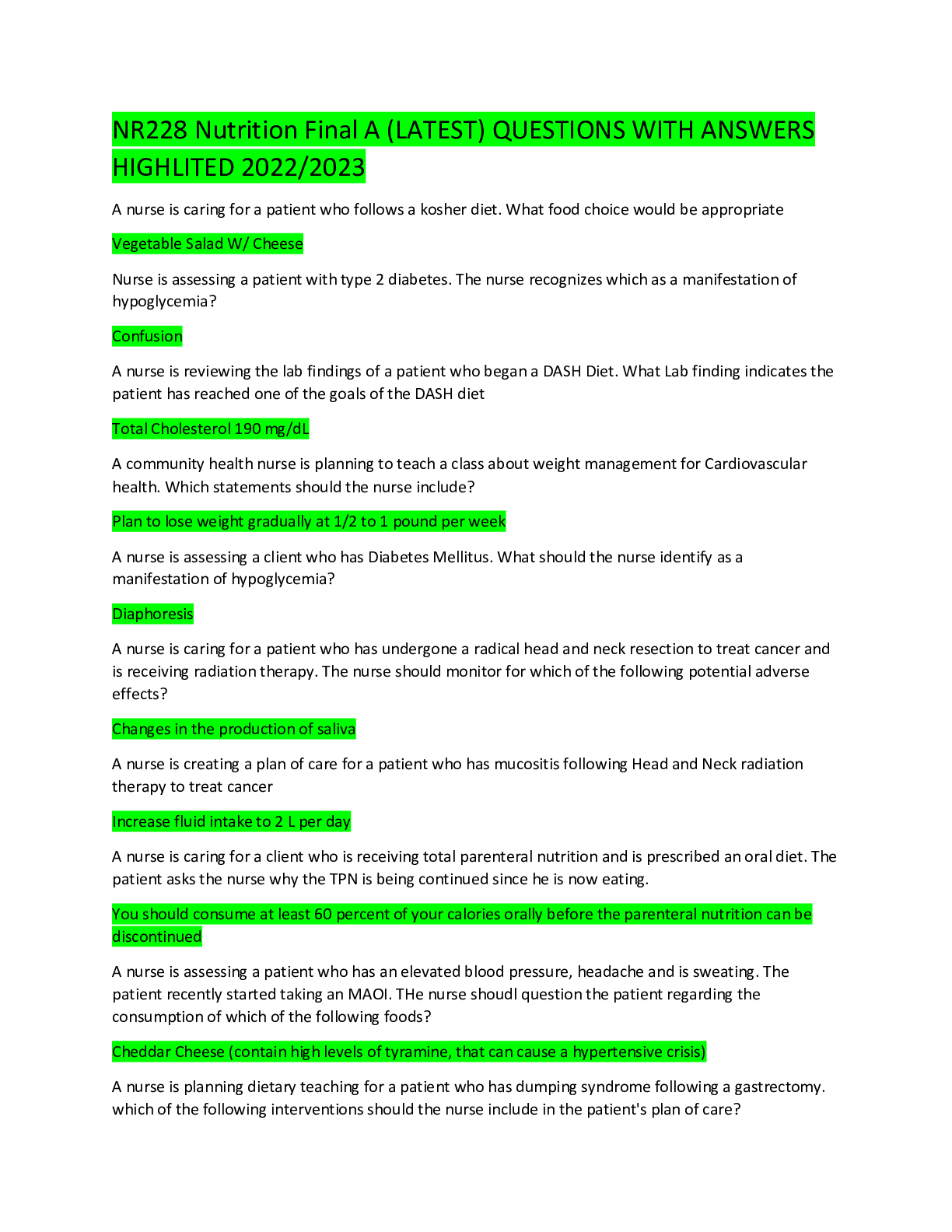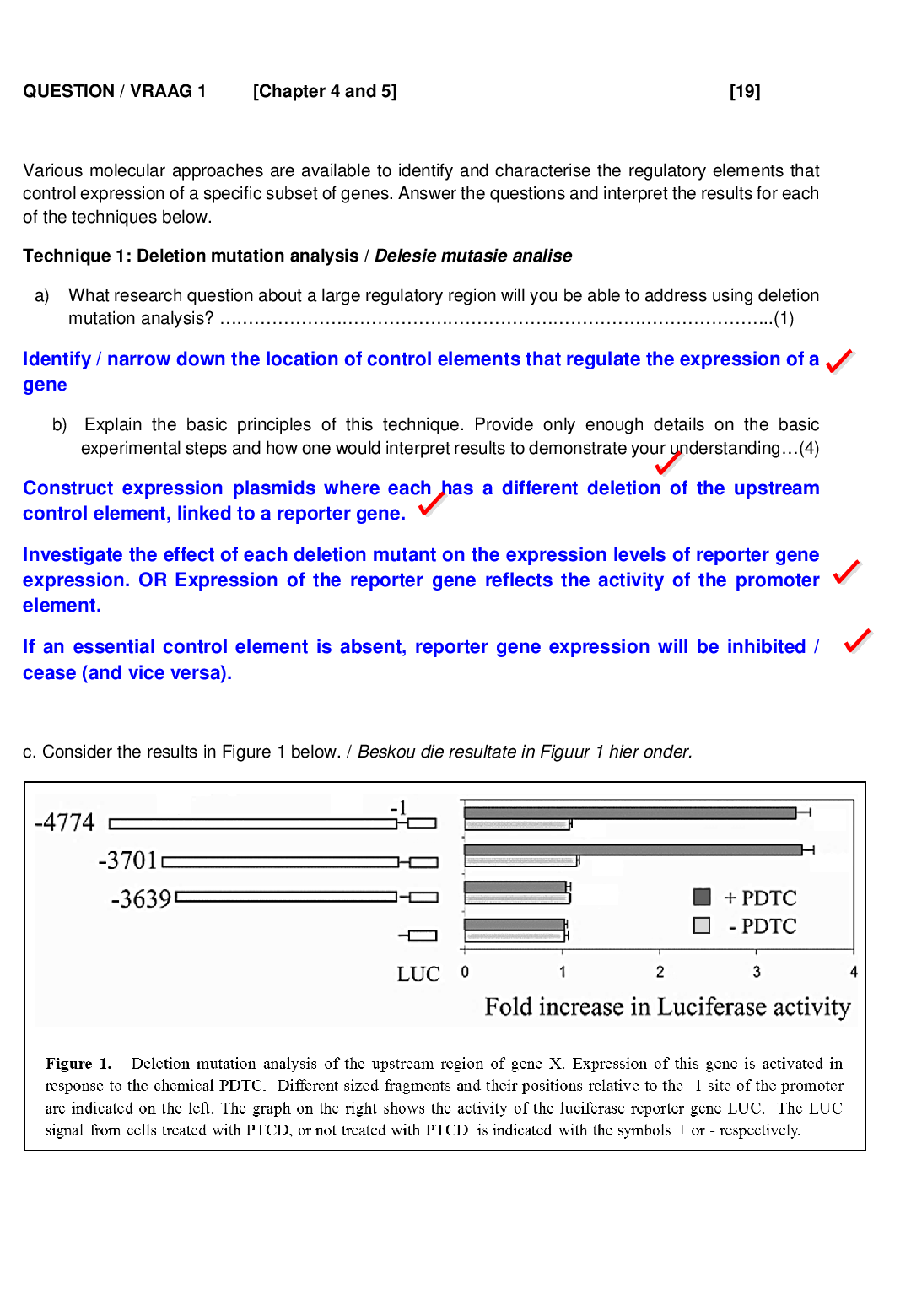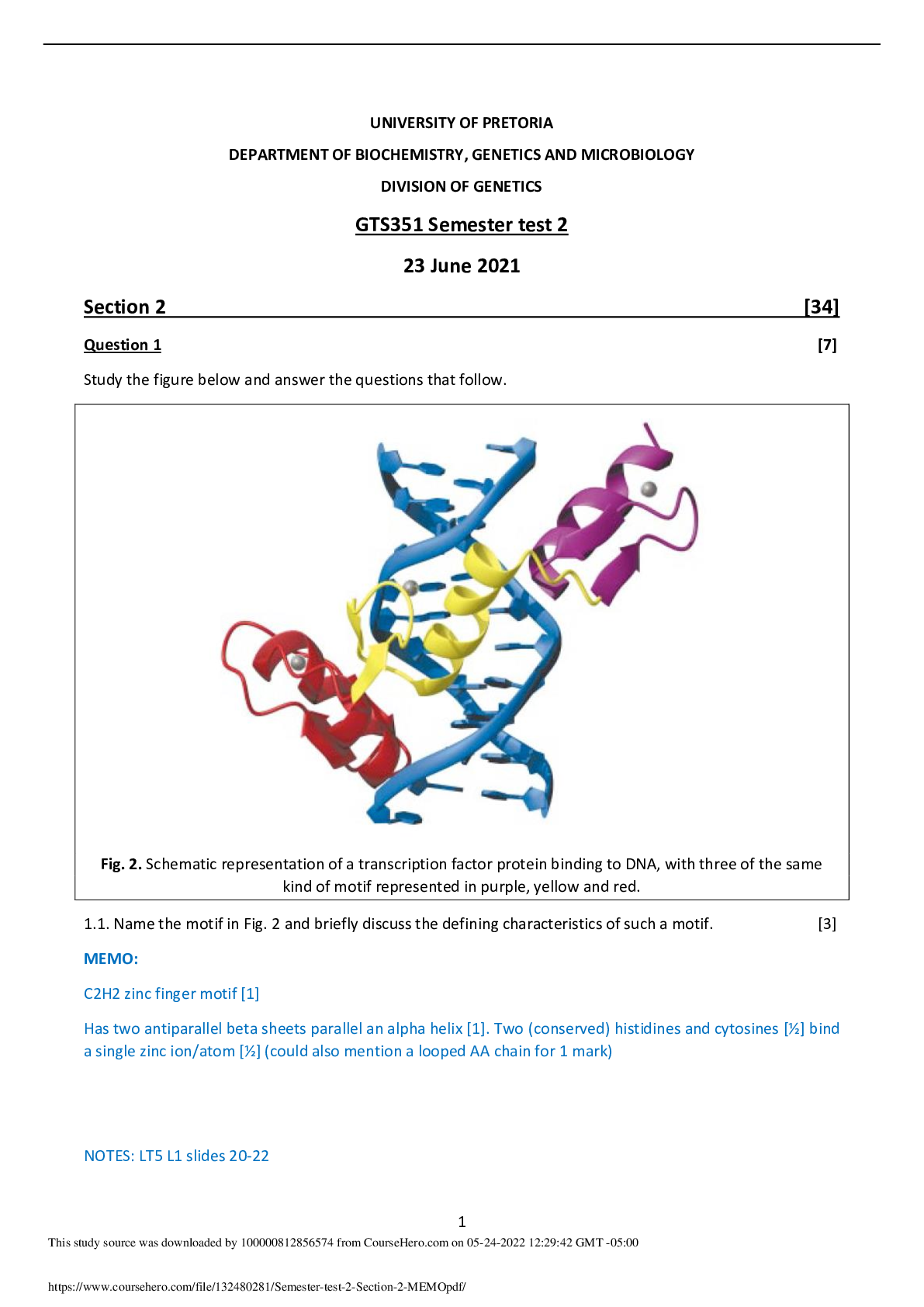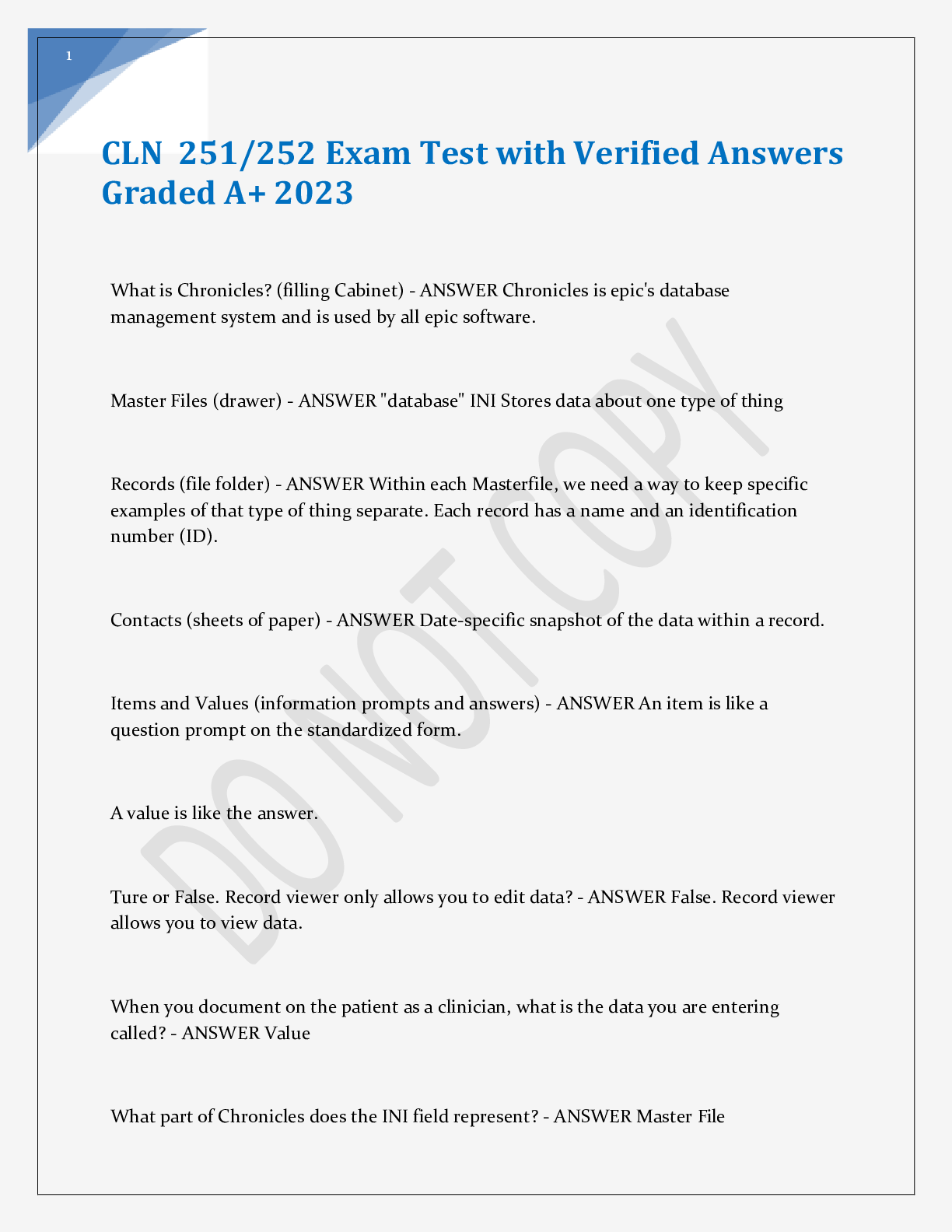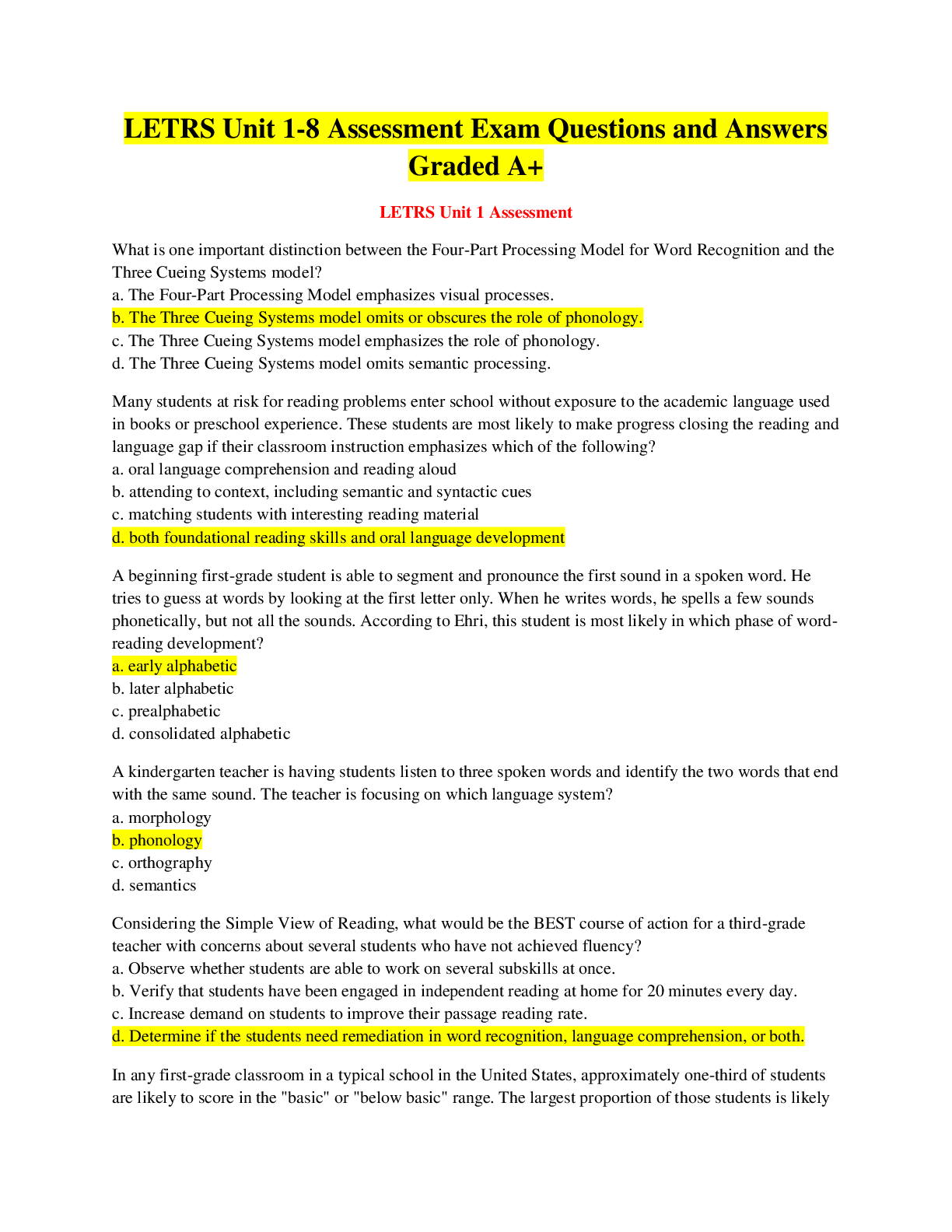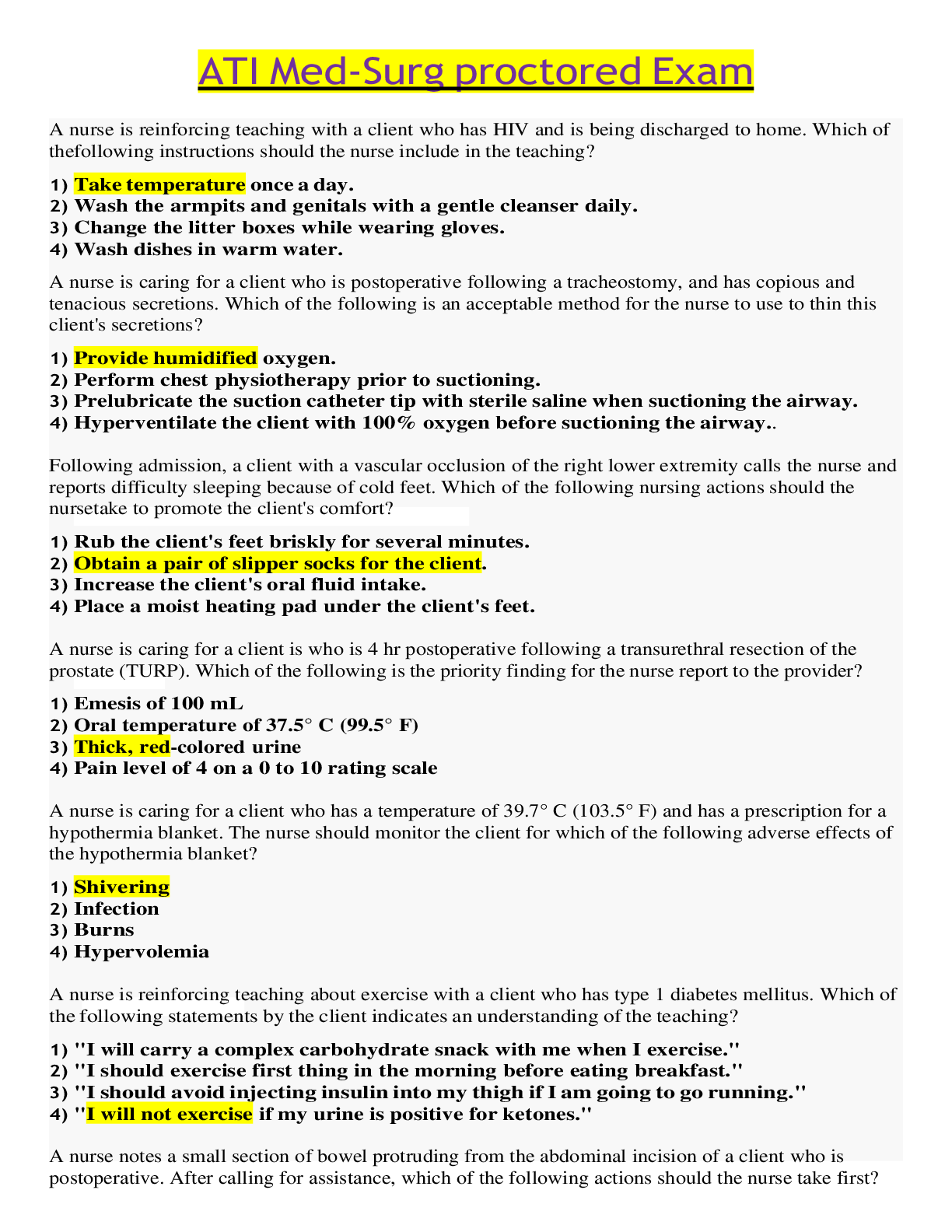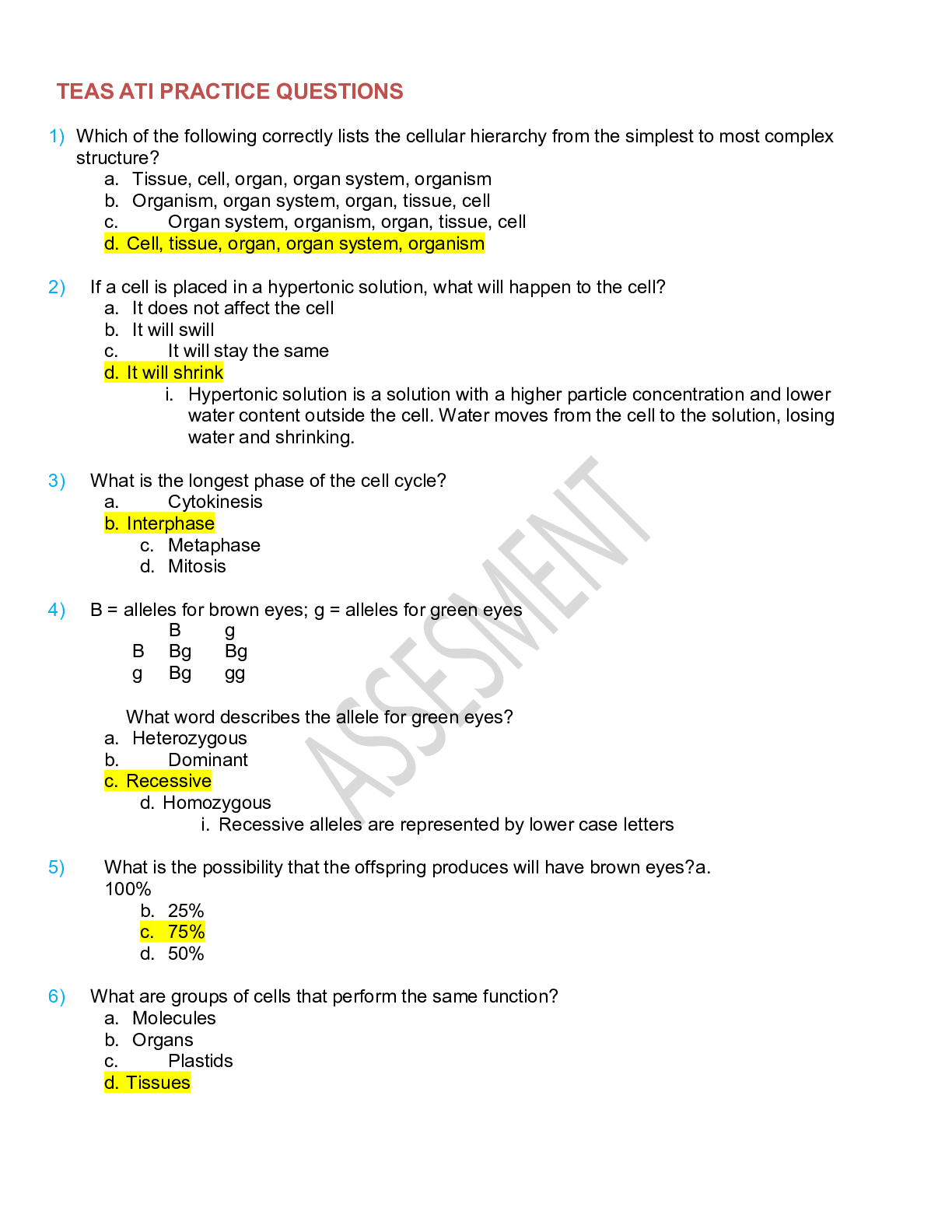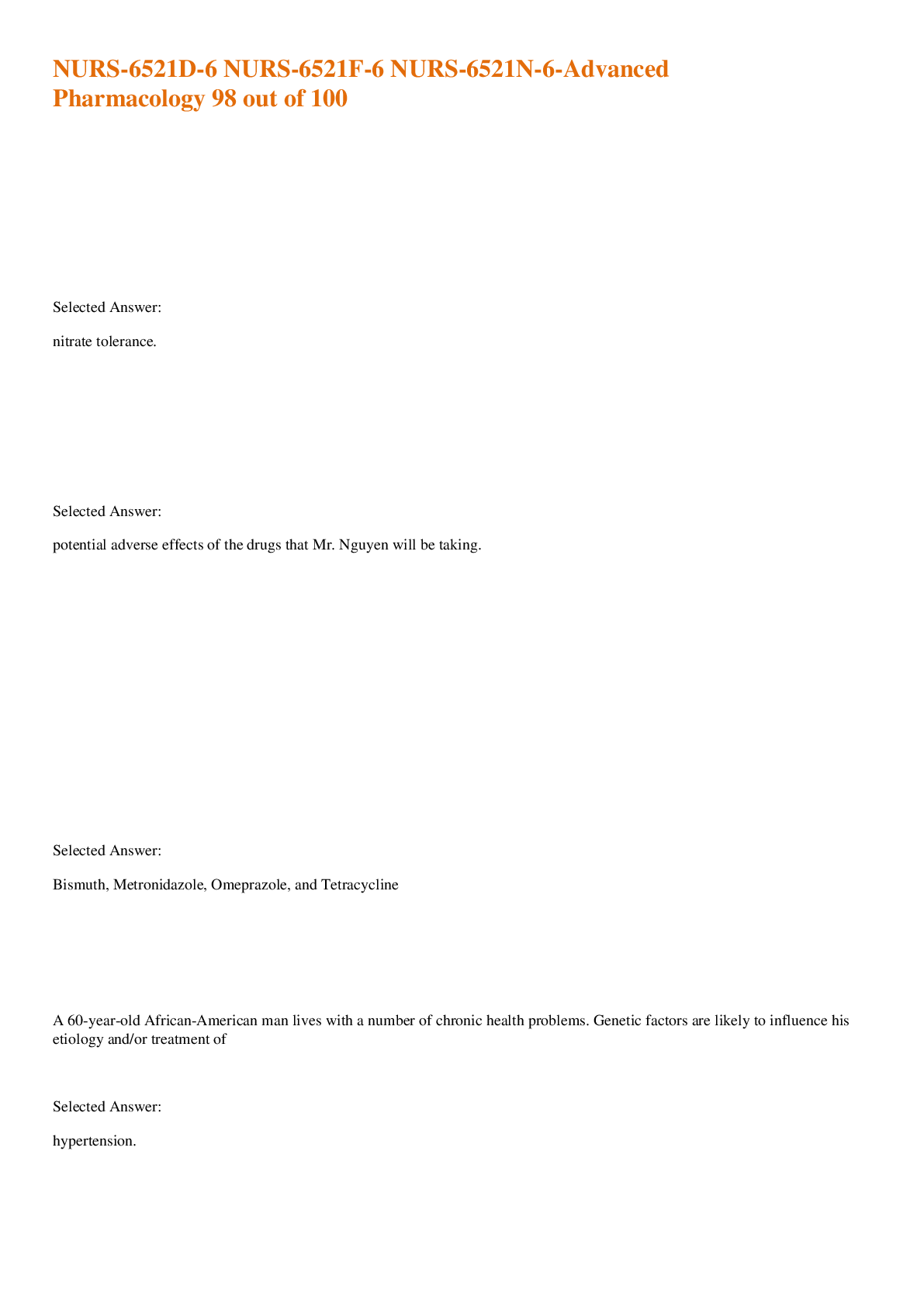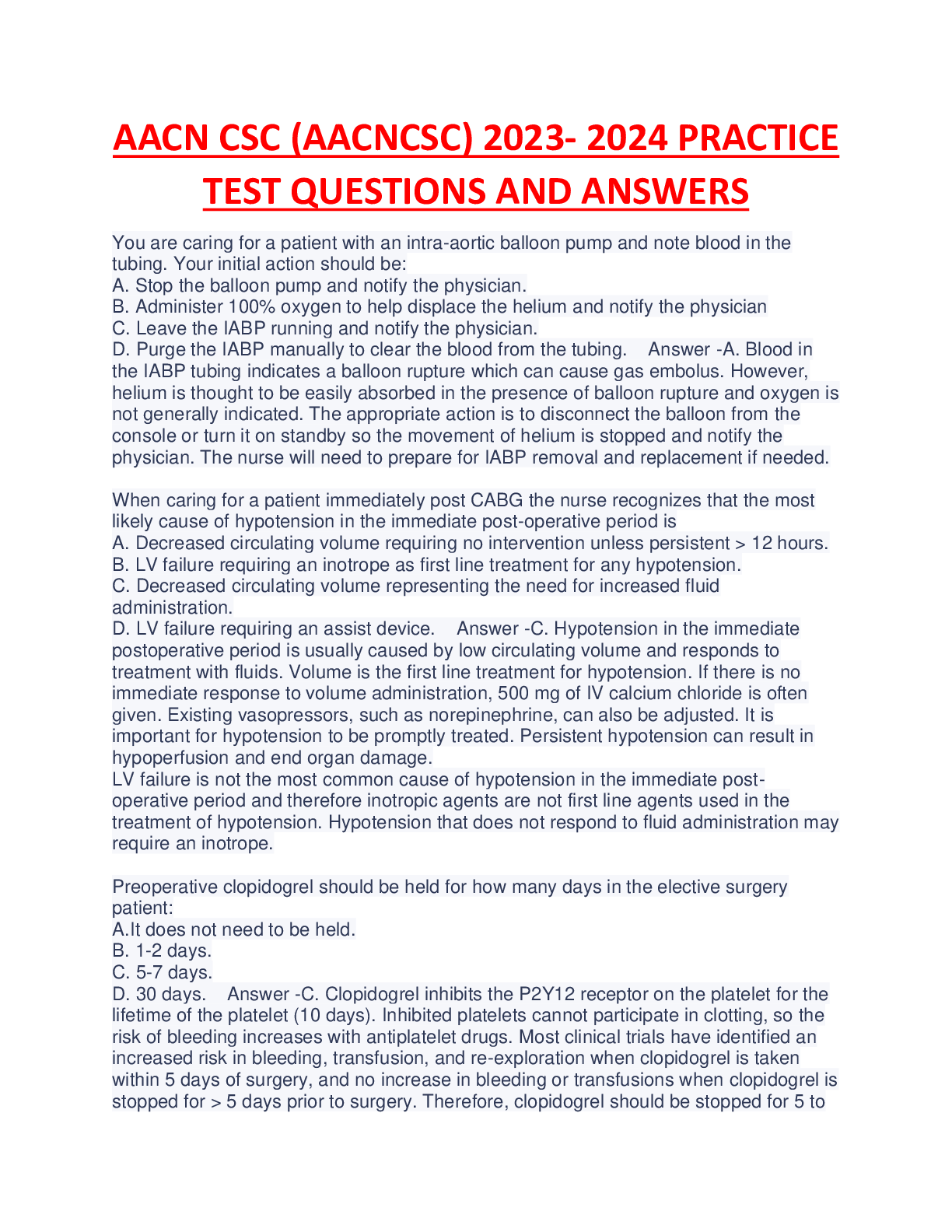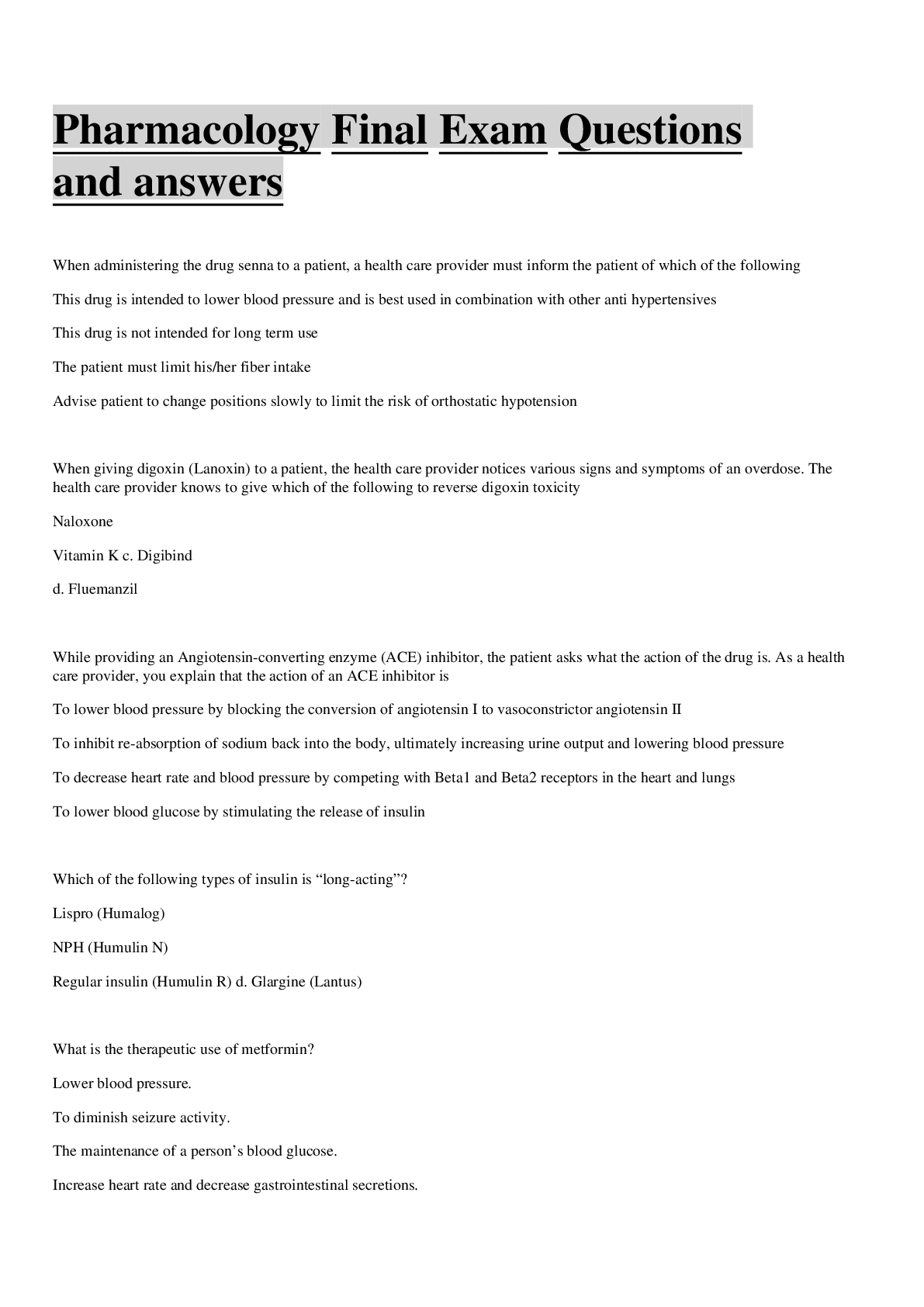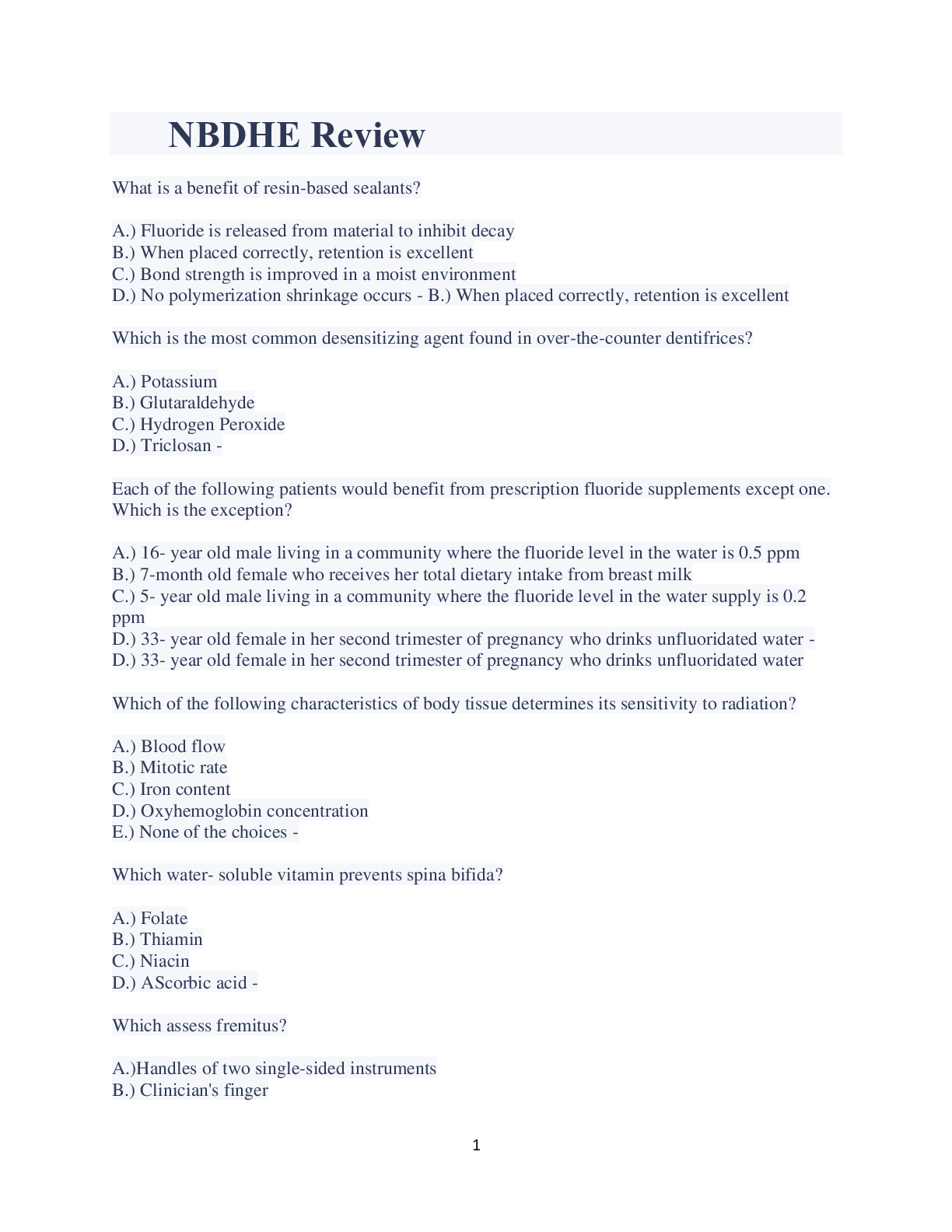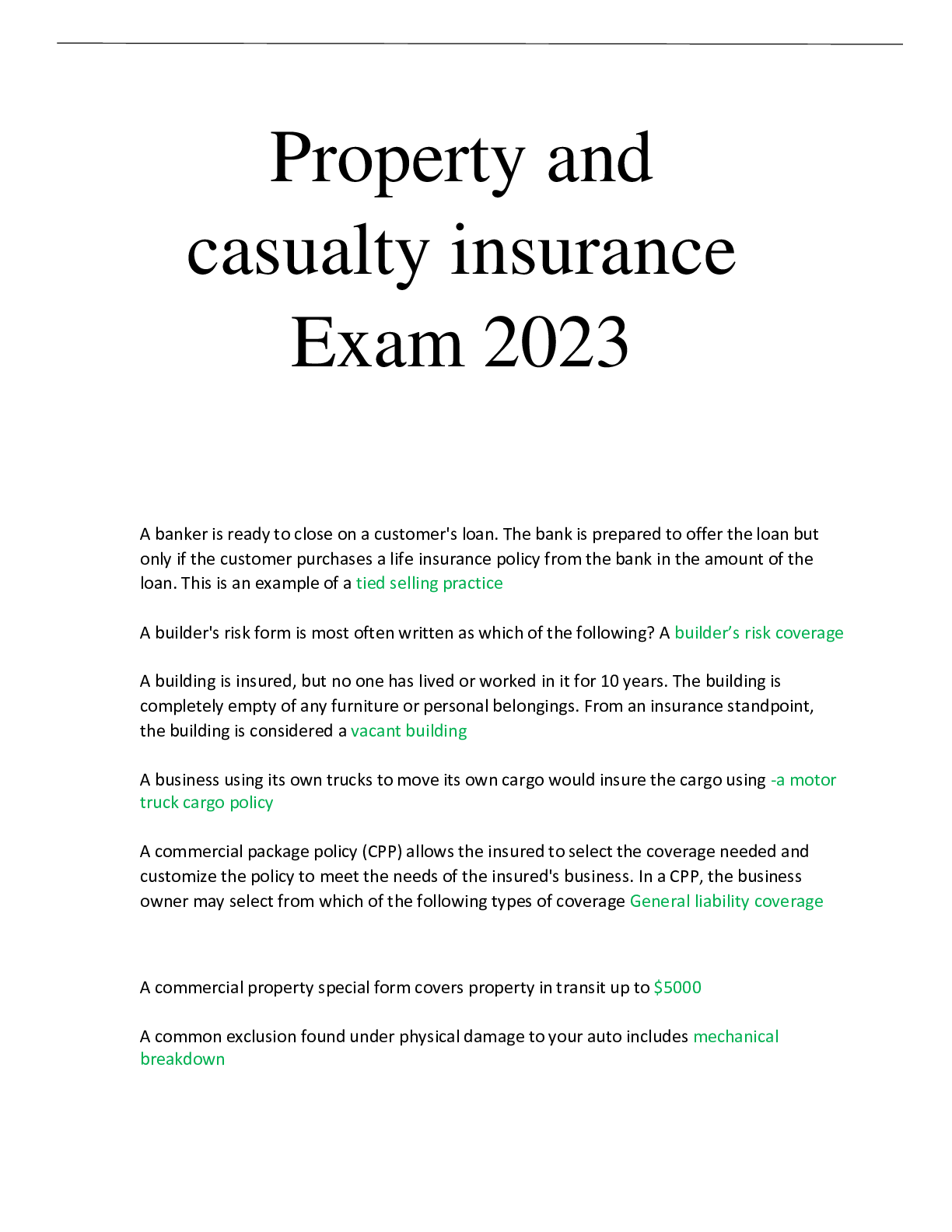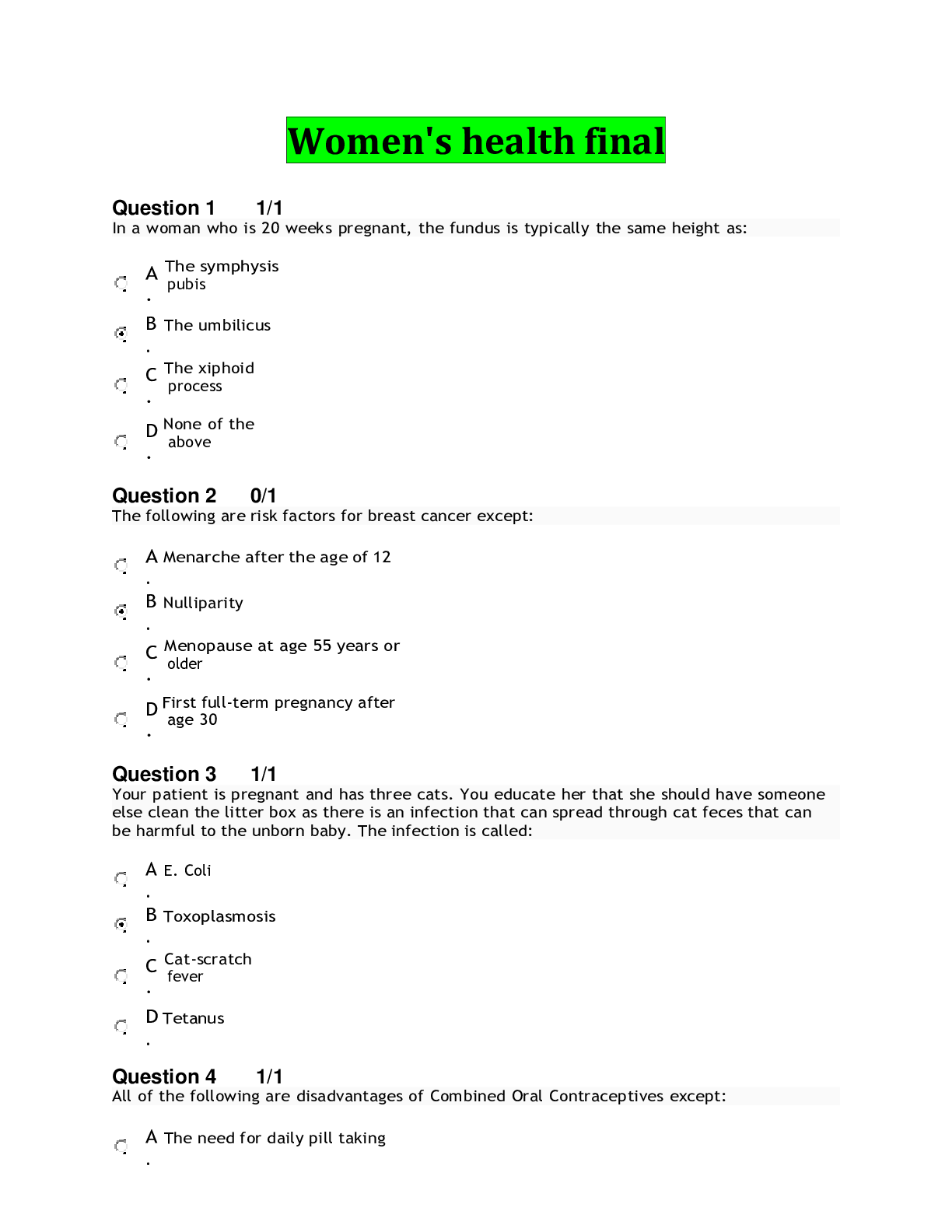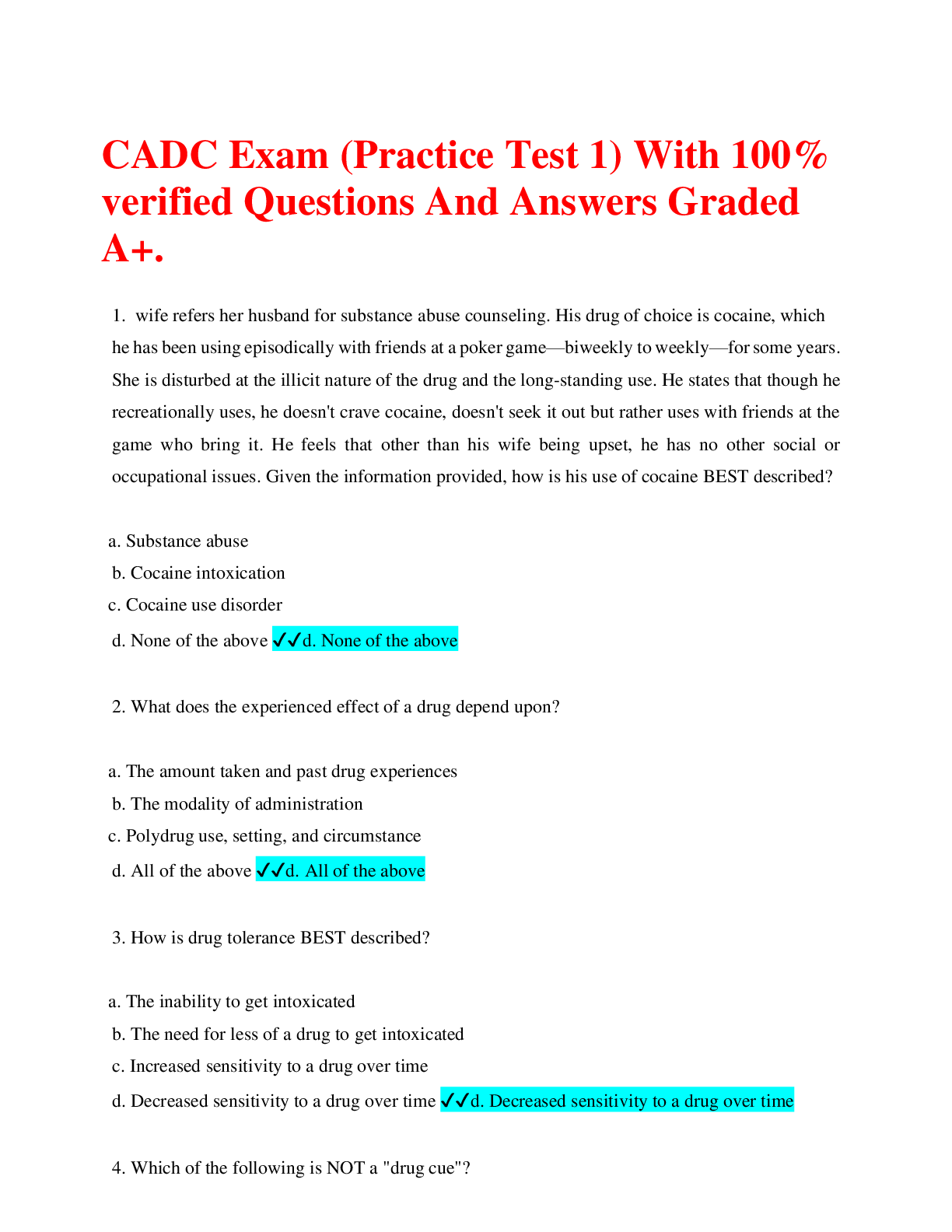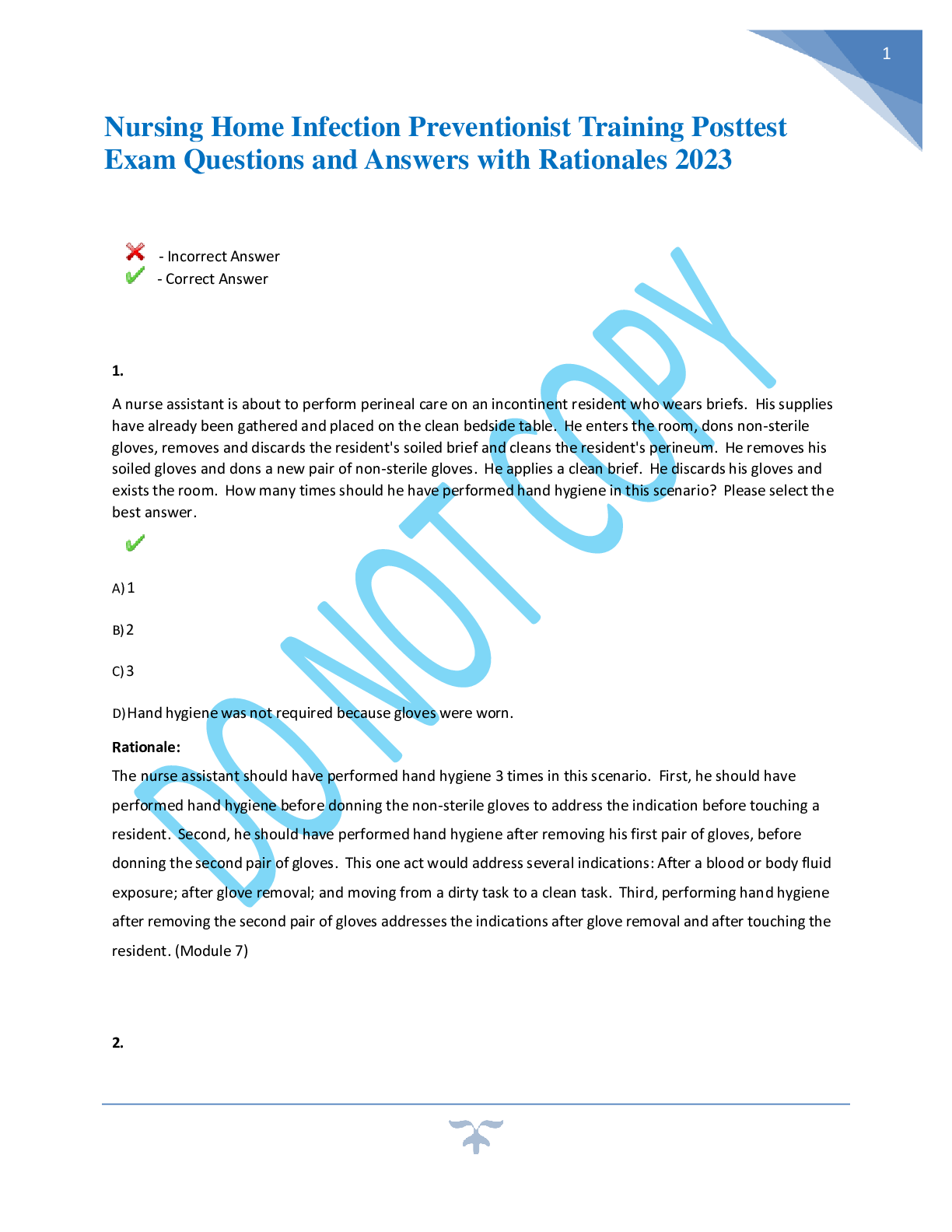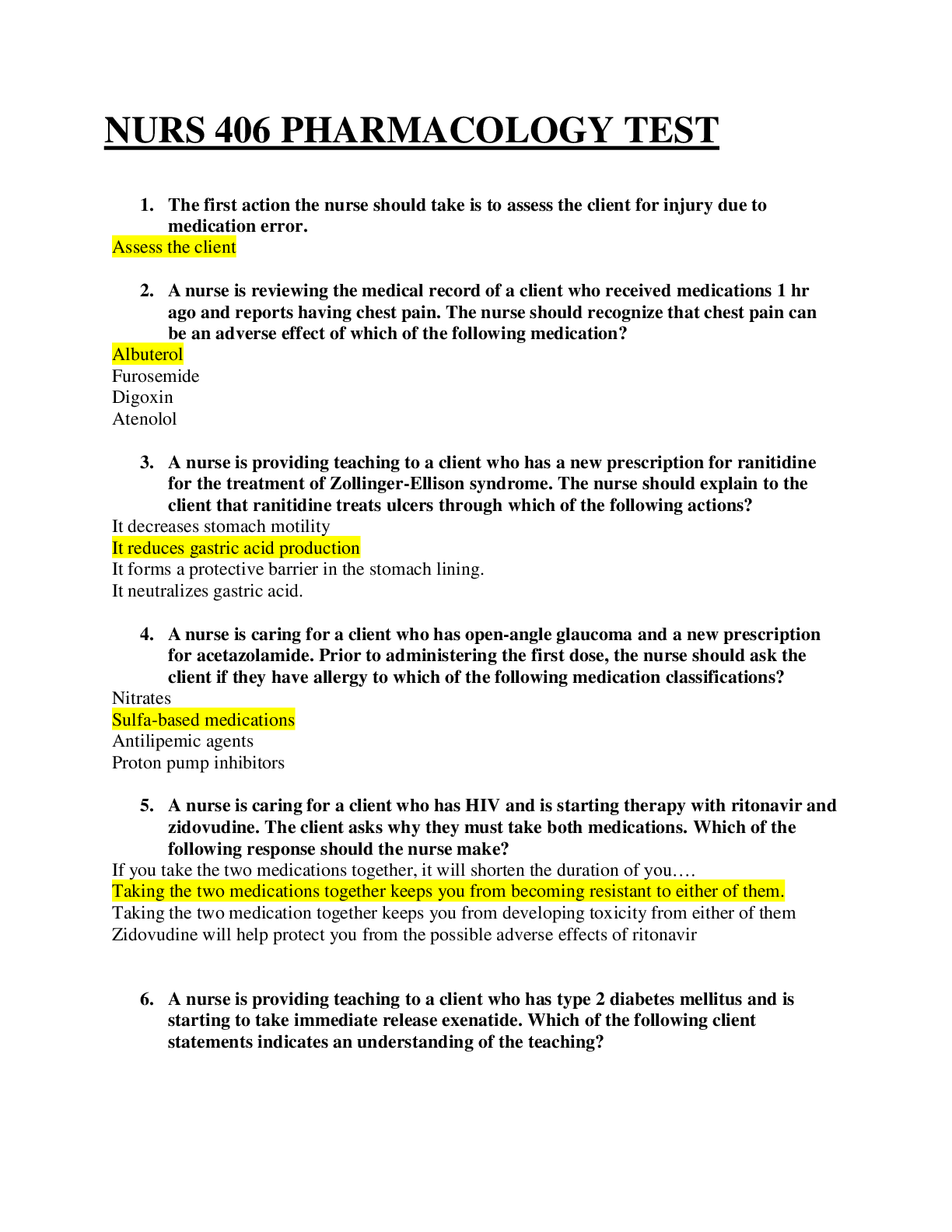NR 602 WOMENS HEALTH FINAL EXAM QUESTIONS AND ANSWERS GRADED A 2021
Document Content and Description Below
Abnormal uterine bleeding (AUB) has multiple causes. When a woman presents and reports menstrual irregularity with amenorrhea, which is the most common cause of amenorrhea? Ectopic pregnancy ... Adenomyosis Coagulopathy Anovulation The Tanner scale of sexual maturity rating allows for accurate classification of physical pubertal maturation. During the examination of your patient, you notice that the pubic hair is increased in quantity, is darker, and is present in the typical female triangle but in a smaller quantity. Which of the following Tanner stages does this description meet? Tanner stage I Tanner stage II Tanner stage III Tanner stage IV A twenty-five-year-old patient presents with urinary frequency and urgency. These symptoms have been occurring for three days without fever. A patient with interstitial cystitis would most likely describe their symptoms as _______. urinary urgency and frequency in the morning and at night pain with urination with scant bleeding terminal dysuria urinary urgency only The most common cause of chronic pelvic pain for women in the prime of their reproductive years is PID Fibroids CORRECT Endometriosis Endometritis A fifty-two-year-old female patient comes in for her annual well-woman examination. Her LMP was fourteen months ago without any breakthrough bleeding. She has also developed some hirsutism. You would document this as __. secondary amenorrhea menopause perimenopause polycystic ovary syndrome (PCOS) Polycystic ovaries predispose women to a higher incidence of: Adrenal tumors Ovarian cancer Endometrial cancer Endometriosis A definitive diagnosis of endometriosis cannot be made until which of these is completed? CT scan Transvaginal ultrasound Exploratory laparoscopy MRI After a thorough history, you note that Marie resides in a community with very high risk factors. These include poverty, violence, and lack of recreational facilities. She tells you that she “hangs out” at a convenience store near the apartment complex she lives at with her mother. “All the group hangs there,” she reports proudly. She shares that she has been menstruating for two years now although she has irregular cycles. She also lets you know that she has had coitus only one time and that he “pulled out.” She does not want to get pregnant, and this is why she is here today. What is your management plan for Marie today? Student Answer: THIS ONE IS WRONG DO NOT CLICK You will assess all predisposing factors that lead to premarital sex and the negative consequences, tell Marie to be careful, and prescribe birth-control pills. CORRECT One by one, you will plan to carefully address the risks (red flags) in Marie’s history. Your goal will be to clarify and address misconceptions, as well as share valuable sex education in a sensitive, nonjudgmental way. You will let her know you are her advocate and are very protective of her health. Without preaching, you want her to be aware of the negative possibilities of premarital, unprotected sexual activities. You will also share a clear understanding of the risk of STIs with Marie. THIS ONE IS WRONG do NOT click IT After processing all of the history Marie has shared, you will write a referral for psychiatric evaluation and tell her she needs ongoing counseling for her behavior at such a young age and she likely needs to learn to cope within her environment (home and community). CORRECT Your goal is to include healthy sexual-health decision making, including decisions regarding abstinence, birth-control efficacy and choice, and condom use. Depending on the need, you may include a referral to an effective program for teens (for example, a program that deals with STI prevention and or a family-based intervention program if available). NO WRONG A well-woman visit for an adolescent should include which of the following? A general health history and physical examination, including a breast examination, pelvic with Pap smear, screening tests, counseling, immunizations, risk factors, and patient concerns A general health history focusing on reproductive and sexual health concerns (menses, gynecologic, and pregnancy related) and psychosocial (family related, peer related, emotional, and physical as well as related to abuse, drug use, and alcohol use) concerns Physical exam, screening tests, and immunizations as indicated by the health history and gynecologic considerations for an external-only inspection of the genitalia CORRECT Both b and c You are completing a pelvic exam on thirty-two-year-old Nancy. You detect a left adnexal mass on the bimanual exam. With an adnexal mass, the practitioner must always suspect ________ until proven otherwise. Pelvic inflammatory disease (PID) Malignancy Pregnancy Polycystic ovary disease X A seventeen-year-old presents with an appointment for unilateral breast tenderness and swelling. Which of the following would be the most likely etiology for this problem? Breast cancer Mastitis Fibrocystic breast Fibroadenoma Majority of urinary tract infections do not require consultation or a referral to a specialist and are routinely treated in primary care practices. Which of the following scenarios would indicate that a consultation or referral is indicated? The presence of secondary sexually transmitted illness A patient with two episodes occurring in one year Patients that remain symptomatic after three days of treatment Patients that show urine human chorionic gonadotropin (HCG) positive Long-acting progestins may be used in patients as a contraceptive method. One of the long-acting progestins is Depo-Provera. Which of the following best describes the mechanism of action of long-acting progestins in contraception? Decrease in cervical mucus production and thinning of the circle os Thickening of cervical mucus and suppression of gonadotropin levels Increased gonadotropin levels and thinning of the circle os Anovulation caused by increased gonadotropin levels Iris is a thirty-two-year-old married woman with three children. She comes in for information on using the copper T intrauterine device (IUD) for contraception. Which of the following would be a contraindication to using this appliance? Prior ectopic pregnancy You are counseling an eleven-year-old girl, Amanda, and her mother about human papillomavirus vaccine (HPV), Gardasil. Amanda is Tanner stage IV at this visit. In counseling this family, you tell them that HPV vaccine ______. is a series of three doses, six months apart will protect Amanda from all strains of HPV can cause seizures in some children is not indicated in her age group as she is not yet sexually active Urinary tract infections are commonly seen in primary care. A twenty-five-year-old female presents with a new onset of dysuria and suprapubic pain for the last twenty-four hours. The examination reveals only mild tenderness without any peritoneal signs on the lower abdomen. A urinalysis reveals the presence of WBCs. The urine is sent for a culture and sensitivity. In addition to Escherichia coli one might typically expect to see the presence of which bacterium? Klebsiella Staphylococcus aureus Staphylococcus saprophyticus Pseudomonas Which of the following conditions is not an absolute contraindication to estrogen-containing contraception? Migraine headaches Hypercoagulable state Thromboembolism History of coronary artery disease Natasha is an eleven-year-old girl brought to your office for an annual well-child visit. When discussing the onset of puberty with Natasha and her mother, you would emphasize which of the following? Breast buds develop before pubic hair. Breast development delayed beyond twelve years of age may be considered pathological. The average age of menarche is nine years. It usually takes about three and half years to go from breast buds to menarche. A woman is experiencing a milky white nipple discharge. Galactorrhea is usually a finding with which other diagnosis? Fibrocystic breast disease Mastalgia Hyperprolactinemia Breast cancer A nurse practitioner is educating a patient who has just been diagnosed with polycystic ovary syndrome (PCOS). She needs to be aware that PCOS is associated with which of the following clinical manifestations? Excessive menstrual flow Dry, flaking skin Obesity Hair loss Anticholinergic medications are a type of treatment for which type of incontinence? Urge incontinence sixty-five-year-old obese female with type II diabetes mellitus presents to your office with a complaint of vaginal itching and burning for two weeks. She has not been sexually active for five years. She has tried douching with an OTC cream with no relief. On physical examination, the vulva is deep red with some thick white adherent material. Which of the following conditions would be the most likely cause of her symptoms? Herpes simplex Lichen planus Atrophic vaginitis Fungal infection One important principle of antiretroviral therapy is Response to drug therapy is monitored by HIV RNA levels. A thirty-two-year-old woman presents to your practice with a chief complaint of postcoital bleeding. Which of the following would not be included in the initial assessment of this patient? pap Uterine biopsy Question 100. Question : The World Health Organization (WHO) has determined absolute contraindications to estrogen containing contraceptives. Which of the following is not an absolute contraindication? History of cerebrovascular accident (CVA) CORRECT Greater than age of thirty-five years Hypertension with vascular disease Active viral hepatitis A twenty-five-year-old patient presents with irregular bleeding after being on oral contraceptives for six months. It is important to rule out which of the following? Chlamydial cervicitis Uterine fibroids Endometriosis Anovulation patient is completing a diary of her premenstrual syndrome (PMS) symptoms. The nurse practitioner understands that PMS occurs with greatest frequency and severity in the ____. Late luteal phase A nurse practitioner instructor is reviewing the anatomy of the external genitalia. At the opening of the vagina are the Bartholin's glands. Which of the following describes the function of these glands? Student Answer: Hormone production for ovulation CORRECT Production of alkaline secretion for sperm viability Development of mucous plug for pregnancy Maintenance of vaginal pH to prevent vaginitis Bartholin's glands There are several phases to the menstrual cycle. What phase begins with menses cessation and ends with ovulation? Ovulatory phase Follicular phase Proliferative phase Luteal phase The most common cause of pelvic pain can be noted as endometriosis. But you also know that the most acute causes of pelvic pain are probably Salpingo-oophoritis (fallopian tube/ovary) secondary to PID ectopic pregnancy?? A nurse practitioner is participating in a sexual education class for children in middle school. Which of the following is important to review as a nonprotective factor against repeat adolescent pregnancy? Use of effective contraception Participation in specialized adolescent parent program CORRECT Continued sexual relationship with the same partner Continued school attendance A teenage patient presents with amenorrhea and normal secondary sex characteristics. A progesterone challenge is ordered. The purpose is to determine the presence of ______. Student Answer: prolactin INCORRECT luteinizing hormone (LH) CORRECT endogenous estrogen follicle-stimulating hormone (FSH) A thirty-nine-year-old female has just completed a course of Amoxicillin for the treatment of streptococcal pharyngitis. Her LMP was two weeks ago and reports that it was normal for her. On physical examination, there is some erythema of the external genitalia with a small amount of white discharge. The microscopic wet prep examination reveals few clue cells but an abundance of budding hyphae. There are no WBCs present. Considering the differential diagnoses and results of the microscopic examination, which of the following would be the most appropriate treatment? Metronidazole 500 mg BID for seven days OTC hydrocortisone 1% cream TID CORRECT Fluconazole tablets 150 mg as a onetime dose Erythromycin 500 mg TID for ten days Which of the following is true regarding education of a forty-two-year-old woman diagnosed with uterine myoma? Myomas usually does not resolve with menopause. Myomas will decrease with the withdrawal of estrogen. Hysterectomy is the treatment of choice. Myomas are never responsible for uterine bleeding. A nurse practitioner is completing a social and medical history of a patient. Which of the following characteristics places her at risk for early menopause? Overweight (BMI 26-29) CORRECT Current smoker Early menarche Nulliparity You are performing an annual well visit on a prepubescent female. Which of the following hormonal changes best describes the fluctuations during this time? A decrease in adrenal cortex androgens The initiation of secretion of follicle-stimulating hormone (FSH) years An increase of adrenal cortex androgens between six and eight years of age Elevation of estrogen levels at eightof age A twenty-one-year-old patient presents with symptoms of lower urinary tract infection, including dysuria, frequency, and urgency. The urinalysis reveals the presence of leukocytes but is negative for nitrates. This most likely represents ______. vaginitis specimen contamination sexually transmitted disease interstitial cystitis A patient has a prescription that was written for birth control pills that now has progestin added to the estrogen therapy. What would this intervention decrease the risk of? Fibrocystic breast disease Amenorrhea Endometrial cancer Osteoarthritis A nurse practitioner is reviewing the chart of a woman who has findings consistent with polycystic ovary syndrome (PCOS).The diagnostic criteria for PCOS include all of the following except: irregular menstrual cycles hyperandrogenism infertility male pattern baldness Breast tissue is composed of glandular, fibrous, and fatty tissue and a complex lymphatic system. Where does lymph from the medial cutaneous area of the breast flow? Axillary nodes Opposite breast Mammary nodes Infraclavicular nodes A thirty-three-year-old woman presents to your clinic complaining of a dark brown, watery vaginal discharge and postcoital bleeding. There is a strong history of multiple unprotected sexual encounters. Which of the following findings on examination would be suspicious for cervical cancer? Ulcerated lesion on the cervical os A soft, pink cervix with no ulcerations An anteverted cervix A very firm, easily friable cervix A fifteen-year-old patient who presents with symptoms consistent with premenstrual syndrome (PMS) is concerned that she may have ovarian cancer. Your best advice to this patient is that PMS is typically caused by which of the following? Polycystic ovarian disease Pituitary tumor Genetic, psychosocial, and hormonal fluctuations Psychosocial issues and sleep disturbance It is known that a woman who is menopausal has an increased risk of heart disease. Which of the following lipid changes occur with estrogen withdrawal in menopause? Decrease in HDL, LDL, and triglycerides Decrease in HDL, LDL, and increase in triglycerides Increase in HDL with a decrease in LDL and triglycerides Decrease in HDL with an increase in LDL and triglycerides Which of the following is an approved treatment for premenstrual dysphoric disorder (PMDD)? Amitriptyline (Elavil) Spironolactone (Aldactone) Drospirenone/ethinyl estradiol/levomefolate calcium (Beyaz) Conjugated estrogen (Premarin) A patient has symptoms consistent with Chlamydia. Which laboratory test would aid in the diagnosis? Detecting the presence of inflammatory cells on a Pap smear Tissue examination using direct fluorescent antibody Culture and sensitivity Wet prep with potassium hydroxide (KOH) assessing for positive “whiff” test A nurse practitioner is counseling a woman with fibrocystic changes in the breast. Which of the following is not caused by this change? Breast pain An increased risk of breast cancer Hard masses Painless lumps A patient is coming to the clinic for a follow-up of some diagnostic testing that she had done. When you review the chart, you find that she now has findings consistent with a diagnosis of polycystic ovary syndrome (PCOS).You recall that PCOS is characterized by which of the following? Menorrhagia Infertility Menometrorrhagia Hypoadrogenism A twenty-five-year-old pregnant client presents with a complaint of headaches that are confined to the base of the head as well as the upper neck and feels “tight” in nature. She denies visual changes, photophobia, or nausea. The most likely diagnosis is which type of headache? Common migraine Cluster Muscular tension Sinus A nurse practitioner is caring for a woman with primary and secondary amenorrhea. The pelvic exam was normal. Which of the following may be the cause if etiology originates in the hypothalamus? Sheehan's syndrome Ovarian failure Thyroid dysfunction Asherman's syndrome You are examining a twenty-nine-year-old female with a three day history of dysuria and urinary frequency. On examination, the patient has mild abdominal pain with palpation in the umbilical area without rebound tenderness. Her test for cerebrovascular accident (CVA) tenderness is negative. This most likely represents which of the following? Pyelonephritis Interstitial cystitis Ectopic pregnancy Ascending urinary tract infection A thirty-five-year-old female presents with perimenopausal symptoms. You recall that this may begin during which age group? Forty-five to fifty years CORRECT Thirty-five to forty years Fifty to fifty-five years Thirty to thirty-five years A woman has been prescribed Depo-Provera injections every three months for contraception. What would be the most likely side effect that she would need to be educated about? CORRECT Abnormal uterine bleeding Dysmenorrhea Nausea Abdominal pain A twenty-four-year-old female presents to the practice with a painless 2 cm, lobular mass in the right breast that is freely mobile and firm. This has been noted on self-breast examination, and she reports it has been unchanged for the past three months. The best course of action by the nurse practitioner would be to __________. order a mammogram referral for surgical excision continue to observe the lesion and recheck in three months determine other risk factors such as family history of breast cancer Which of the following choices represents a disorder of the reproductive tract that causes pain, erythema, dyspareunia, and a perineal mass? Syphilis CORRECT Bartholin’s cyst Labial adhesion Herpes simplex type 2 A twenty-four-year-old female patient has been diagnosed with primary dysmenorrhea. Which of the following medications would be used as a first line to help control her symptoms? Antianxiety agents Progesterone-only contraception Oral steroids CORRECT Nonsteroidal anti-inflammatory drugs Changes in hormonal regulation during menopause result in the gradual cessation of menstruation. From which gland is Androstenedione secreted? Anterior pituitary Posterior pituitary Corpus Luteum CORRECT Adrenals A postmenopausal woman is concerned because she is having postcoital bleeding. Which of the following would be the most likely etiology? Cervical cancer Endometrial cancer CORRECT Atrophic vaginitis Polycystic ovary syndrome (PCOS) A fifty-five-year-old woman presents to the clinic for evaluation of a breast mass. Which of the following is not a typical presenting sign of breast cancer? Engorgement of one areola and nipple Dimpling of skin over breast Unilateral retraction and deviation of nipple CORRECT A 2 cm, rubbery, tender lesion A thirty-two-year-old patient comes in for a workup of infertility. During the history, the nurse practitioner suspects that the patient may be experiencing anovulatory cycles. In order to confirm ovulation, which of the following tests would be most appropriate to order? Endometrial biopsy CORRECT Basal body temperature Hysterosalpingogram Postcoital testing A seventeen-year-old female patient presents with amenorrhea for four months. She did experience menarche at the age of fifteen but had not had a menstrual cycle since. On physical examination, it is noted that she has normal secondary sexual characteristics. The nurse practitioner will consider a progesterone challenge to determine the presence of adequate __. CORRECT endogenous estrogen prolactin L-thyroxine follicle-stimulating hormone (FSH) A couple is presenting for a first trimester pregnancy exam. They are curious about the sex of the baby. You recall that the human embryo becomes bipotential at what week of gestation? Sixth Tenth Twelfth CORRECT Eighth A sixteen-year-old girl who comes to your office with a history of secondary amenorrhea. She experienced menarche at age ten, with regular cycles for two years. She has not menstruated now for four years. In your initial consideration of differential diagnoses, what is the most frequent etiology of this problem? CORRECT Eating disorder Pregnancy Anovulatory cycles Stress According to Neinstein, all stages of adolescent psychosocial development revolve around issues with independence/dependence, body image concerns, peer group involvement, and identity development. During which stage are eating disorders most likely to surface? Early adolescence (10 to 13 years) Middle adolescence (14 to 16 years) Older adolescence (17 to 21 years) All of the above Tanisha is a twenty-two-year-old woman who presents with extreme irritability and mood swings, bloating, constipation, fluid retention, and headache. She tearfully tells you, “This happens every month in my cycle. I get like a crazy woman, lashing out at everyone. I’m afraid I’ll lose my job if I can’t stop this. Sometimes, it’s so bad. I just want to quit living. I need help!” Tanisha’s symptoms are typical of what disorder? Depression Premenstrual syndrome (PMS) Bipolar disorder Premenstrual dysphoric disorder (PMDD) Elisabeth comes for a consultation. She has been in a committed relationship for five years now and wants to become pregnant. She is seeking information on the menstrual cycle and her “fertile period.” Her cycle is twenty-eight days and regular. She and her partner have used condoms consistently to avoid pregnancy. Which of the following would be most valuable to her initially? The viability period for sperm is twenty-four hours. Ovulation occurs on day 14 +/– 2 days, before next period. Taking her temperature daily will tell her when she is fertile. Cervical mucus evaluation can be used to determine fertility. Strategies to protect teenagers from risks include all of the following except ___ involving them in community activities for a worthy cause encouraging them to participate in team building sports pairing young adolescents with middle adolescents involving them in school-related activities thirty-nine-year-old female has just completed a course of Amoxicillin for the treatment of streptococcal pharyngitis. Her LMP was two weeks ago and reports that it was normal for her. On physical examination, there is some erythema of the external genitalia with a small amount of white discharge. The microscopic wet prep examination reveals few clue cells but an abundance of budding hyphae. There are no WBCs present. Considering the differential diagnoses and results of the microscopic examination, which of the following would be the most appropriate treatment? Metronidazole 500 mg BID for seven days OTC hydrocortisone 1% cream TID CORRECT Fluconazole tablet one time dose Erythromycin 500 mg TID for ten days A forty-four-year-old woman with dysfunctional uterine bleeding (DUB) presents for treatment. Which of the following medications can be used for management of DUB? Ethinyl estradiol Medroxyprogesterone Estrogen/progesterone combination Conjugated estrogen A patient is completing a diary of her premenstrual syndrome (PMS) symptoms. The nurse practitioner understands that PMS occurs with greatest frequency and severity in the ____. late luteal phase midfollicular phase proliferative phase early luteal phase The onset and duration of puberty varies greatly from patient to patient and is also dependent upon race. Which of the following phrases can you expect to have the earlier onset of puberty in boys? African American boys Native American boys Caucasian boys Hispanic boys Oral contraceptive agents may contain both progesterone and estrogen. The progesterone component of the oral contraceptive produces which the following effects? Decrease in luteinizing hormone (LH) CORRECT Cervical mucus production Increased levels of follicle-stimulating hormone (FSH) Thinning of the cervical os During pregnancy and lactation, the nutritional needs of the woman are increased with deficiencies resulting in harm to the woman or her baby. Neural tube defects are one of the most common birth defects. Deficiency of which nutrient is responsible for these conditions? Vitamin C CORRECT Folic acid Vitamin B12 Riboflavin During a community education program, a nurse practitioner is discussing the usefulness of mammography in the screening and detection of breast cancer. Which of the following statements is accurate? A mammogram should be done if there is any breast pain or nipple retraction. All women over forty years of age should have a mammogram on an annual basis. A mammography should be done annually for all women of child-bearing age. Mammograms should be performed annually after the initial pregnancy, especially if the woman does not breast-feed. A twenty-five-year-old patient presents with irregular bleeding after being on oral contraceptives for six months. It is important to rule out which of the following? Chlamydial cervicitis Uterine fibroids Endometriosis Anovulation The National Osteoporosis Foundation has screening guidelines for DEXA scans. Which of the following women would be most in need of bone mineral density testing? A sixty-year-old postmenopausal woman receiving hormone replacement therapy (HRT) A fifty-year-old woman who is having irregular menstrual cycles A fifty-one-year-old woman with COPD on long-term corticosteroid therapy A forty-nine-year-old, obese Caucasian woman who smokes A patient asks why she needs a breast ultrasound when she already has had a mammogram. Which of the following would be the best response of the use? To locate small lesions prior to surgery As a screening test for breast cancer To determine if a breast lesion is cystic or solid For definitive diagnosis of breast cancer A thirty-one-year-old female presents for contraceptive counseling following the birth of their first child. She is interested in using the diaphragm as her method of contraception. Which of the following statements is true regarding the use of this device? The device may be inserted up to twenty-four hours prior to intercourse. The device may be left in place for up to twelve hours. The device may be inserted at any time up to six hours prior to intercourse. The device should be removed within one hour after intercourse. In reviewing cancer statistics, after breast cancer, what would you find to be the most common female genital malignancy? Endometrial Ovarian Vulvovaginal Cervical A twenty-four-year-old female presents to the office with a complaint of vaginal itching in addition to thick mucoid discharge. She also has some mild urinary discomfort. A wet mount preparation using potassium hydroxide (KOH) reveals a negative whiff test and few clue cells. There were no trichomonads visualized but the WBCs were too numerous to count. Which of the following would be the most likely diagnosis in this patient? Bacterial vaginosis Herpes simplex Chlamydia Cystitis with cervicitis A woman is concerned that she may develop breast cancer. Which of the following is not an associated risk factor for this? Late menarche Family history Nulliparity Late menopause Breast masses are a common finding in adolescents and most typically are benign. Which of the following descriptions of a breast mass most likely represents a benign finding? Bilateral, round, or oval firm mass Unilateral, round mass with hard consistency Bilateral, round, or oval for mass with dimpling of the nipple Multiple unilateral masses with hard consistency found in the axilla Which of the following statements best describe the difference between type I and type II bone loss in patients with osteoporosis? Type II bone loss involves the trabecular compartment Type II bone loss results from loss of ovarian function Type I bone loss involves the cortical bone Type I bone loss results from loss of ovarian function A thirty-two-year-old woman presents to your practice with a chief complaint of postcoital bleeding. Which of the following would not be included in the initial assessment of this patient? Papanicolaou smear Uterine biopsy Pelvic ultrasound CBC with diff A nurse practitioner is performing a wet mount with potassium hydroxide (KOH) to assist with a diagnosis in a woman experiencing vaginal discharge. Which of the following would this confirm? Herpes simplex Trichomonas Candidiasis Chlamydia A sixty-five-year-old obese female with type II diabetes mellitus presents to your office with a complaint of vaginal itching and burning for two weeks. She has not been sexually active for five years. She has tried douching with an OTC cream with no relief. On physical examination, the vulva is deep red with some thick white adherent material. Which of the following conditions would be the most likely cause of her symptoms? Herpes simplex Lichen planus Atrophic vaginitis Fungal infection A nurse practitioner is educating a patient who has just been diagnosed with polycystic ovary syndrome (PCOS). She needs to be aware that PCOS is associated with which of the following clinical manifestations? Excessive menstrual flow Dry, flaking skin CORRECT Obesity Hair loss A twenty-eight-year-old female presents with breast tenderness, fatigue, abdominal bloating, fluid retention, and irritability one week prior to the onset of her menses. The nurse practitioner suspects the patient may have premenstrual syndrome (PMS). What is the most important information to obtain from this patient to make the determination? Severity of symptoms CORRECT Occurrence of symptoms in the menstrual cycle Frequency and number of symptoms over the past four months Presence or absence of depression or anxiety A woman is experiencing a milky white nipple discharge. Galactorrhea is usually a finding with which other diagnosis? Fibrocystic breast disease Mastalgia CORRECT Hyperprolactinemia Breast cancer Natasha is an eleven-year-old girl brought to your office for an annual well-child visit. When discussing the onset of puberty with Natasha and her mother, you would emphasize which of the following? CORRECT Breast buds develop before pubic hair. Breast development delayed beyond twelve years of age may be considered pathological. The average age of menarche is nine years. It usually takes about three and half years to go from breast buds to menarche. Which of the following conditions is not an absolute contraindication to estrogen-containing contraception? : CORRECT Migraine headaches Hypercoagulable state Thromboembolism History of coronary artery disease A thirty-six-year-old type I diabetic patient is considering starting on an oral contraceptive method. She is on both insulin and oral antidiabetic agents. The patient should be informed that ____. Student Answer: oral contraception is contraindicated in diabetic patients a common side effect is hyperglycemia hypoglycemic effects may be antagonized CORRECT an increase in insulin dosing may be recommended A twenty-five-year-old patient is on oral contraception and comes in with an elevated blood pressure after being on the medication for six months. Prior to the initiation of the medication, the patient's blood pressure had been within normal limits. The patient should be advised that ____. most likely the oral contraceptive is not causing the blood pressure elevation CORRECT approximately over 3% oral contraceptive users develop hypertension most likely progesterone is causing blood pressure elevation blood pressure elevation results from fluid retention A forty-one-year-old patient is currently on griseofulvin for the treatment of onychomycosis. As an advanced practice nurse, you would advise the patient that this medication has the potential for which of the following? Increase estrogen secretion Decrease steroid levels Increase follicle-stimulating hormone (FSH) secretion Decrease progesterone secretion A twenty-two-year-old female presents with an initial onset of herpes simplex on the external genitalia. During the patient education, which of the following statements is most important to include? Cesarean section will be necessary for any pregnancy and delivery. Antiviral medications will be useful in treating and curing an outbreak. The sexual partner will not contract herpes if lesions are not present. Symptoms of the initial outbreak of the lesions are typically worse than subsequent outbreaks. When educating patients about the use of combination oral contraceptive medications, they should be advised that pregnancy is prevented primarily by ____________. cervical mucus thinning inflammation of the endometrium CORRECT ovulation suppression decreased fallopian tube motility Urinary tract infections are commonly seen in primary care. A twenty-five-year-old female presents with a new onset of dysuria and suprapubic pain for the last twenty-four hours. The examination reveals only mild tenderness without any peritoneal signs on the lower abdomen. A urinalysis reveals the presence of WBCs. The urine is sent for a culture and sensitivity. In addition to Escherichia coli one might typically expect to see the presence of which bacterium? Klebsiella Staphylococcus aureus CORRECT Staphylococcus saprophyticus Pseudomonas A female patient is concerned about using combination oral contraception that includes both estrogen and progesterone. You instruct her that the medication actually will decrease risks of which of the following cancers? CORRECT Endometrial Breast Cervical Ovarian Adolescence sexuality is important to understand and to discuss with your patients. Sexual behavior begins with childhood curiosity. Based upon the following characteristics, you would define your patient in which level of adolescence: low physical and mental investment in sexuality, information gathering on the topic of sexuality, prepubertal appearance and masturbation. CORRECT Preadolescence Early adolescence Middle adolescence Late adolescence A woman is completing a symptom diary of her symptoms associated with premenstrual syndrome (PMS). In which of the following phases would the problems most likely appear? Ovulatory Follicular Proliferative CORRECT Late luteal You are counseling an eleven-year-old girl, Amanda, and her mother about human papillomavirus vaccine (HPV), Gardasil. Amanda is Tanner stage IV at this visit. In counseling this family, you tell them that HPV vaccine ______. CORRECT is a series of three doses, six months apart will protect Amanda from all strains of HPV can cause seizures in some children is not indicated in her age group as she is not yet sexually active Gynecomastia or breast development in males is a common issue in clinical practice. Which of the following statements defines Gynecomastia most accurately? It is always unilateral. CORRECT Onset coincides with the start of puberty. Illegal drug use is rarely a cause. An endocrine workup should be instituted in all cases. A school nurse is reviewing a female student’s records regarding presence of the human papillomavirus vaccine (HPV). Which of the following statements most clearly represents the current guidelines with respect to immunization against HPV? The vaccine targets HPV types 19 and 21. The HPV vaccine should be given as early as age eight. HPV immunization should be given after initial sexual contact. CORRECT The HPV vaccine is initiated at ages eleven or twelve. A nurse practitioner has just completed education with a female adolescent about intrauterine contraceptive devices. Which of the following statements by the patient would suggest that further education is needed? They are only indicated for women with stable monogamous relationships. It is not commonly used for nulliparous women as there are better options. They are contraindicated in women with a past history of pelvic inflammatory disease. CORRECT They may be used by a woman who has had a previous ectopic pregnancy. Anna, aged twenty-five years, presents with dysmenorrhea. She states that her sister and her mother have endometriosis and she would like to be evaluated for it as well. Which if the following is consistent with a diagnosis of endometriosis? Frequent episodes of bacterial vaginosis Postcoital bleeding with malodorous discharge Infertility and dysmenorrhea Constipation and amenorrhea Long-acting progestins may be used in patients as a contraceptive method. One of the long-acting progestins is Depo-Provera. Which of the following best describes the mechanism of action of long-acting progestins in contraception? Decrease in cervical mucus production and thinning of the circle os CORRECT Thickening of cervical mucus and suppression of gonadotropin levels Increased gonadotropin levels and thinning of the circle os Anovulation caused by increased gonadotropin levels The ovaries are located near the pelvic wall at the level of the anterior superior iliac spine. Which layer of the ovaries contains the lymphatics and blood vessels? Endometrium CORRECT Central medulla Cuboidal epithelium Ovarian stroma A female child presents for a well-child exam. Her mother is concerned about changes in her daughter’s body, which indicate to you precocious puberty. Which of the following findings would be consistent with this diagnosis? Delay in any of the Tanner stages takes longer than one year between stages Breast budding occurs after the development of pubic hair CORRECT Puberty starts before eight years of age in a female The growth spurt in a female occurs after puberty is complete fifty-one-year-old postmenopausal patient presents with renewed onset of vaginal bleeding. She had not menstruated for more than one year. Physical examination, including abdominal and pelvic examination appears grossly normal. Your initial treatment for this patient would include which of the following? Observe the patient and have her return of the bleeding continues Medroxyprogesterone acetate 5 to 10 mg daily to control bleeding Monophasic oral contraceptives for three months and then reassess Referral to a gynecologist for consideration for endometrial biopsy A nurse practitioner is educating a pregnant female about breast changes. Common normal physiologic changes include all of the following except: Development of straie CORRECT Fibrocystic changes Nipple pigmentation Venous engorgement You are instructing a patient in the proper use of the diaphragm, a barrier contraceptive method. Which of the following would you include in your instructions? The diaphragm should be removed within two hours after intercourse. The diaphragm may be inserted up to twelve hours prior to intercourse. CORRECT The diaphragm is more effective when used with spermicidal jelly. Douching is safe immediately upon removal of the diaphragm. When educating a patient about the rationale for obtaining a mammogram, which of the following statements is false? Mammography is a cost-effective method to screen for breast cancer CORRECT Mammography detects all breast cancers Mammography should be accompanied by breast examination Negative mammography should not delay biopsy of a clinically suspicious mass nurse practitioner is completing a speculum exam on a female patient. Which of the following findings would be considered a normal surface characteristic of the cervix? CORRECT Small, yellow, raised around area on the cervix Friable, bleeding tissue opening of the cervical os Red patch areas with occasional white spots Irregular, granular surface with red patcheserm Majority of urinary tract infections do not require consultation or a referral to a specialist and are routinely treated in primary care practices. Which of the following scenarios would indicate that a consultation or referral is indicated? The presence of secondary sexually transmitted illness A patient with two episodes occurring in one year CORRECT Patients that remain symptomatic after three days of treatment Patients that show urine human chorionic gonadotropin (HCG) positive pregnant A twenty-five-year-old female presents with vaginal irritation and discharge. On examination, the cervix is easily friable and erythematous. There is no adnexal tenderness. The wet prep microscopic examination reveals mobile protozoa on the normal saline slide. This most likely represents _________. CORRECT trichomonas mucopurulent cervicitis bacterial vaginosis gonorrhea A thirty-five-year-old female presents for her normal annual examination and complains of recent changes in her breasts. She reports that they feel tender and “lumpy” during certain times of the month. As a result, she does not perform self-breast examination as she had been doing in the past. Which of the following statements would offer the best advice to this patient? Order a mammogram to establish baseline data. Recommend that she perform a self-breast examination every two months. Determine the time of the month when her breasts are tender and recommend a change to her breast self-examination schedule. Stress the importance of breast self-examination to detect unusual lumps. A seventeen-year-old presents with an appointment for unilateral breast tenderness and swelling. Which of the following would be the most likely etiology for this problem? Breast cancer Mastitis Fibrocystic breast Fibroadenoma A fifty-two-year-old female patient comes in for her annual well-woman examination. Her LMP was fourteen months ago without any breakthrough bleeding. She has also developed some hirsutism. You would document this as __. secondary amenorrhea CORRECT menopause perimenopause polycystic ovary syndrome (PCOS) A twenty-five-year-old patient presents with urinary frequency and urgency. These symptoms have been occurring for three days without fever. A patient with interstitial cystitis would most likely describe their symptoms as _______. urinary urgency and frequency in the morning and at night Correct pain with urination with scant bleeding terminal dysuria urinary urgency only You are completing a well visit on a fourteen-year-old female who is currently not menstruating. Primary amenorrhea is best described as ________. cessation of menstruation for six months CORRECT failure of menstruation to occur by age fifteen failure of menstruation to occur by age thirteen cessation of menstruation for six months after menarche A Pap smear result of atypical squamous cells of undetermined significance (ASCUS) will require which procedure next? Cold knife cone (CKC) CORRECT Follow-up Pap smear Colposcopy Loop electro-excision procedure (LEEP) A patient has been ordered a breast ultrasound after having a mammogram. The primary rationale for ordering this is to _____. screen for breast cancer breast cancer staging CORRECT determine if a breast lesion is cystic or solid evaluate for structural abnormalities During puberty, linear growth is determined by the amount of growth hormone (GH) and the feedback loop. Which of the following patterns describes the release of GH in patients in puberty? Rapid secretion of GH with activity Pulsatile release in the morning GH release that increases at rest CORRECT Pulsatile release at the onset of slow wave sleep Bodily image concerns can be a major problem during the adolescent years. Which of the following psychosocial developmental phases of adolescence represents a period of greatest concern over bodily image? Middle adolescence Late adolescence Preadolescence Early adolescence A thirty-five-year-old woman, presents with a six-month history of hypermenorrhea, backache, and pelvic pressure. On examination, you discover a twelve-week size uterus with irregular contour. Which of the following does this represent? Uterine cancer Dysfunctional uterine bleeding (DUB) CORRECT Uterine fibroid Fecal impaction A nurse practitioner is teaching an undergraduate pathophysiology class about changes associated with puberty. Which of the following is an inaccurate point that should not be included? A decrease in the sensitivity of the hypothalamus An elevation of luteinizing hormone (LH) and follicle-stimulating hormone (FSH) Decreasing estrogen levels and a reduction in gonadotropin-releasing hormone (GnRH) Nocturnal secretion of pulsatile LH The pituitary gland is responsible for a variety of functions with respect to hormonal regulation and is composed of two lobes, the anterior and posterior sections. Which of the following list of hormones are secreted by the anterior pituitary gland? Growth hormone (GH) and thyroid-stimulating hormone Prolactin and T4 Follicle-stimulating hormone (FSH) and T3 Luteinizing hormone (LH) and oxytocin A sixty-one-year-old thin, Caucasian female presents to your practice for a well-woman examination. She remarks that she feels like she is shrinking over the past year, despite keeping active and incorporating sources of calcium in her diet. Which of the following is not a risk factor for osteoporosis? Excessive exercise History of maternal osteoporosis Routine use of alcohol or caffeine CORRECT Use of opposed Estrogen use The first line treatment of severe menstrual cramps that have been occurring for four months in a patient with primary dysmenorrhea includes which of the following? Acetaminophen CORRECT Ibuprofen Combination hormone replacement therapy (HRT) Amitriptylineerm A patient who a nurse practitioner is seeing for the first time has the past medical history of primary dysmenorrhea. She recalls that which of the following is considered as the primary etiology? Ovarian cysts CORRECT Prostaglandin production Endometriosis AdenomyosisTerm A woman presents for her prenatal visit and has a diagnosis of preeclampsia or pregnancy-induced hypertension (PIH). The nurse practitioner is educating the patient about the diagnosis. Which of the following about PIH indicates that the nurse practitioner has made an incorrect statement? Symptoms include edema of the hands and face Symptoms occur during the second trimester Proteinuria is a late development in PIH CORRECT PIH is a precursor to chronic hypertension and heart disease A diagnosis has been formulated on a patient as premenstrual syndrome (PMS). Which of the following medication regimes is the best treatment for the PMS? Vitamin B6, Antiprostaglandins, and Diuretics Calcium, Antidepressants, and Vitamin D Vitamin B6, Calcium, and Acetaminophen Evening Primrose Oil, Ginkgo Biloba, and Antidepressants There are several phases to the menstrual cycle. What phase begins with menses cessation and ends with ovulation? follicular A progesterone challenge is ordered. The purpose is to determine the presence of _ Estrogen primed endometrium its to see if a woman is still secreting estrogen A nurse practitioner instructor is reviewing the anatomy of the external genitalia. At the opening of the vagina are the Bartholin's glands. Which of the following describes the function of these glands? Helps protect vagina secretes fluid to lubricate Hormone production for ovulation Production of alkaline secretion for sperm viability Development of mucous plug for pregnancy Maintenance of vaginal pH to prevent vaginitis There are several phases to the menstrual cycle. What phase begins with menses cessation and ends with ovulation When you inspect her external genitalia, you are amazed at the size and appearance of the "lump." You note what appears to be an abscess on the left medial side of the labia minora, and there is some edema extending into the perineum. Your diagnosis for this presentation is: Bartholin's cyst You explain to this young woman what this "lump" is and let her know you will be referring her to a gynecologist you consult with regularly. You explain to her the likely treatment as follows: A possible incision might be necessary and a catheter (WORD) placed for two to four weeks to allow for drainage and appropriate healing. Treatment for stress incontinence can include Pelvic muscle exercises/kegel floor exercises Biofeedback Weight loss if obese Signs and symptoms reported for hyperthyroidism enlarged thyroid, decreased libido, heat intolerance, diaphoresis, insomnia, weight loss with increased appetite, nervousness, palpitations, increased gastrointestinal response (such as frequent bowel movements), menstrual irregularities, and exercise intolerance. Signs and symptoms for hypothyroidism enlarged thyroid; depression; decreased libido; cold intolerance; dry, coarse skin; weight gain with poor appetite; fatigue; slow thinking; hypersomnia; muscle weakness; constipation; and menstrual irregularities. Phases of Menstrual Cycle 4 phases -Follicular Phase: Proliferative or Preovulating phase (follical-when the egg is in the ovaries) -Ovulation -Luteal Phase: secretory of postovulatory phase -Menstruation The diagnosis of stress incontinence can be confirmed by the woman's symptom history to date Thalia is a fifteen-year-old who is referred to your women’s health practice by her school counselor. She has macromastia and has been teased and ridiculed by her classmates at school. Which of the following would be the first step in dealing with this problem? Encourage Thalia to wear loose clothing and a bra with strong support. Refer Thalia to a therapist for counseling and support, including antibullying. Meet with Thalia and her parents to discuss options, including breast reduction surgery. Assess Thalia’s Tanner staging for breasts and date of menarche. Which of the following characteristics is not associated with psychosocial development problems in adolescence? Being different than others or feeling different Late onset of pubertal sexual maturity Sexual identity as GLBTQ Having a disability or chronic health condition Abby, twenty years old, presents with pelvic pain. Which of the following is not a first-line diagnostic test for evaluation of pelvic pain? Pregnancy test CBC with differential CT of pelvis Urinalysis Mitzi, a twenty-three-year-old, is here for her well-woman checkup. She asks about douching. Which of the following statements about douching is true? Douching is a reliable contraceptive method. Douching may increase the risk of infection and ectopic pregnancy. Douching effectively prevents sperm from entering the uterus. Douching should be used after intercourse and after menses. You are meeting with twenty-two-year-old Emily to discuss birth control options. She has tried “the pill” in the past but failed to take it regularly. She is interested in depo because she only has to come in every three months for a shot. She also heard that one does not get a period on depo, and she likes the thought of that. Which of the following would be a specific consideration with depo that you would need to discuss? Depo offers no protection from STIs. Depo depletes skeletal mass, so it is necessary to take calcium supplements. As with any hormonal birth control, changes in weight can occur. Depo does not offer pregnancy protection for those who are obese. There are several phases to the menstrual cycle. What phase begins with ovulation and ends with menstruation? Ovulatory phase Follicular phase Proliferative phase Luteal phase A nurse practitioner is educating a woman who has a colposcopy ordered. Which of the following most accurately describes a colposcopy? A procedure that visualizes the vaginal, vulvar, or cervical epithelium with magnification to identify abnormal areas that may need to be biopsied A procedure to visualize the uterine cavity through a small, fiber-optic scope introduced through the cervix A procedure to remove a sample of endometrial tissue with a curette or an aspiration tool for biopsy A procedure to visualize the abdominal and pelvic cavity by fiber-optic endoscope via a subumbilical incision A pregnant woman has been diagnosed with preeclampsia or pregnancy-induced hypertension (PIH). Which of the following statements about PIH is incorrect? One of the manifestations is edema of the hands and face. The timing of PIH is usually after the twentieth week of pregnancy. Proteinuria is a late development in PIH. PIH is a precursor to chronic hypertension and heart disease. A pregnant client in your practice is experiencing nausea and vomiting in her first trimester. Which of the following would you suggest to alleviate the problem? Avoiding all carbonated beverages, including sodas and seltzer water Eating small meals at frequent intervals, avoiding spicy or fatty foods Avoiding eating the first thing on awakening in the morning Taking additional iron and prenatal vitamins A pathology report has been returned on a woman’s breast mass malignancy. The most common type of invasive breast cancer is ______ lobular infiltrating ductal infiltrating papillary medullary A woman presents to the office seeking the birth control measure that is 100% effective. When counseling a woman on effectiveness of these methods, which of the following fulfills this requirement? Implanon Combined oral contraceptive Abstinence Intrauterine device (IUD) A thirty-three-year-old woman presents to your clinic complaining of a dark brown, watery vaginal discharge and postcoital bleeding. There is a strong history of multiple unprotected sexual encounters. She has not been immunized for human papillomavirus (HPV). Which of the following examination findings would be suspicious for cervical cancer? Lymphadenopathy of the femoral area A soft, pink cervix with no ulcerations An anteverted cervix with lateral displacement A very firm cervix with an ulcer Which of the following choices represent a disorder of the reproductive tract that causes pain, erythema, dyspareunia, and a perineal mass? Endometrial polyp Bartholin’s cyst Cervical polyp Pilonidal cyst A young woman presents to your practice with vaginal itching and a white discharge. She denies sexual activity or douching. She has been in good health except for a recurrent strep throat. Pelvic examination reveals a tender vulvovaginal area with edema and white patches; no odor is detected. Which of the following is the most likely cause of this problem? Bacterial vaginosis Diabetes mellitus Allergy to personal hygiene product Candidiasis after antibiotic treatment Lauren, twenty-three years old, presents to your office with a complaint of severe menstrual cramps for four months since she quit using an oral contraceptive. Your tentative diagnosis is primary dysmenorrhea. What would be the first-line treatment for this condition? Acetaminophen Naproxen Ergotamine Elavil A twenty-one-year-old woman presents for her initial well-woman examination. She has never been sexually active and has a negative family history for gynecology problems. Personal history is negative for abuse, and she exercises regularly and eats a balanced diet. Menstrual history reveals that she experienced menarche at fourteen years of age, has a regular twenty-eight-day cycle, and denies dysmenorrhea. Which of the following would be included in her physical examination today? Stool for occult blood Baseline mammography Cultures for gonorrhea and chlamydia Pap smear Sally, a sixty-one-year-old Caucasian female, presents to your practice for a well-woman examination. She remarks that she feels like she is shrinking over the past year, despite keeping active and incorporating sources of calcium in her diet. Which of the following is not a risk factor for osteoporosis? Smoking History of maternal osteoporosis Excessive use of alcohol or caffeine Use of combined oral contraception You are seeing a twenty-two-year-old pregnant woman for routing antepartal care. She discloses that she forgets to take her prenatal vitamins. Which of the following would not be part of your counseling and education? Try putting them next to your toothbrush and taking them at night when you brush before going to bed. Using an OTC stool softener and drinking plenty of water can help with constipation. You can just take a regular multivitamin in place of the prenatals. Prenatal vitamins are specially formulated to prevent anemia in you and your baby. Which of the following is an approved treatment for premenstrual dysphoric disorder (PMDD)? Drospirenone/ethinyl estradiol/levomefolate calcium (Beyaz) Soybean milk (Soy) Amitriptyline (Elavil) Conjugated estrogen (Premarin) Karen is concerned that she may develop breast cancer. Which of the following is not an associated risk factor? Older age Family history Nulliparity Breastfeeding The National Osteoporosis Foundation has screening guidelines for DEXA scans. Which of the following women would be most in need of bone mineral density testing? A fifty-four-year-old postmenopausal woman receiving hormone replacement therapy (HRT) A fifty-year-old woman who is having irregular menstrual cycles A fifty-one-year-old woman with systemic lupus erythematosus (SLE) on long-term corticosteroid therapy A forty-nine-year-old Caucasian woman who smokes and has an excessive alcohol intake Lenore, fifty-five years old, comes in for evaluation of a breast mass. Which of the following is not usually linked with carcinoma of the breast? Scaly lesions similar to eczema on one areola and nipple Peau d’orange dimpling of skin over breast Unilateral retraction and deviation of nipple Well-circumscribed, rubbery, and tender lesion Bodily image concerns can be a major problem during the adolescent years. Which of the following psychosocial developmental phases of adolescence represents a period of greatest concern over bodily image? Middle adolescence Late adolescence Preadolescence Early adolescence During puberty, linear growth is determined by the amount of growth hormone (GH) and the feedback loop. Which of the following patterns describes the release of GH in patients in puberty? Rapid secretion of GH with activity Pulsatile release in the morning GH release that increases at rest Pulsatile release at the onset of slow wave sleep A school nurse is reviewing a female student’s records regarding presence of the human papillomavirus vaccine (HPV). Which of the following statements most clearly represents the current guidelines with respect to immunization against HPV? The vaccine targets HPV types 19 and 21. The HPV vaccine should be given as early as age eight. HPV immunization should be given after initial sexual contact. The HPV vaccine is initiated at ages eleven or twelve. The onset and duration of puberty varies greatly from patient to patient and is also dependent upon race. Which of the following phrases can you expect to have the earlier onset of puberty in boys African American boys Native American boys Caucasian boys Hispanic boys A diagnosis has been formulated on a patient as premenstrual syndrome (PMS). Which of the following medication regimes is the best treatment for the PMS? Vitamin B6, Antiprostaglandins, and Diuretics Calcium, Antidepressants, and Vitamin D Vitamin B6, Calcium, and Acetaminophen Evening Primrose Oil, Ginkgo Biloba, and Antidepressants A patient who a nurse practitioner is seeing for the first time has the past medical history of primary dysmenorrhea. She recalls that which of the following is considered as the primary etiology Ovarian cysts Prostaglandin production Endometriosis Adenomyosis You are completing a well visit on a fourteen-year-old female who is currently not menstruating. Primary amenorrhea is best described as ________. cessation of menstruation for six months failure of menstruation to occur by age fifteen failure of menstruation to occur by age thirteen cessation of menstruation for six months after menarche A fifty-one-year-old postmenopausal patient presents with renewed onset of vaginal bleeding. She had not menstruated for more than one year. Physical examination, including abdominal and pelvic examination appears grossly normal. Your initial treatment for this patient would include which of the following? Observe the patient and have her return of the bleeding continues Medroxyprogesterone acetate 5 to 10 mg daily to control bleeding Monophasic oral contraceptives for three months and then reassess Referral to a gynecologist for consideration for endometrial biopsy Gynecomastia or breast development in males is a common issue in clinical practice. Which of the following statements defines Gynecomastia most accurately? It is always unilateral. Onset coincides with the start of puberty. Illegal drug use is rarely a cause. An endocrine workup should be instituted in all cases. Adolescence sexuality is important to understand and to discuss with your patients. Sexual behavior begins with childhood curiosity. Based upon the following characteristics, you would define your patient in which level of adolescence: low physical and mental investment in sexuality, information gathering on the topic of sexuality, prepubertal appearance and masturbation. Preadolescence Early adolescence Middle adolescence Late adolescence Breast masses are a common finding in adolescents and most typically are benign. Which of the following descriptions of a breast mass most likely represents a benign finding? Bilateral, round, or oval firm mass Unilateral, round mass with hard consistency Bilateral, round, or oval for mass with dimpling of the nipple Multiple unilateral masses with hard consistency found in the axilla A fifteen-year-old patient who presents with symptoms consistent with premenstrual syndrome (PMS) is concerned that she may have ovarian cancer. Your best advice to this patient is that PMS is typically caused by which of the following? Polycystic ovarian disease Pituitary tumor Genetic, psychosocial, and hormonal fluctuations Psychosocial issues and sleep disturbance The pituitary gland is responsible for a variety of functions with respect to hormonal regulation and is composed of two lobes, the anterior and posterior sections. Which of the following list of hormones are secreted by the anterior pituitary gland? Growth hormone (GH) and thyroid-stimulating hormone Prolactin and T4 Follicle-stimulating hormone (FSH) and T3 Luteinizing hormone (LH) and oxytocin A nurse practitioner is educating a pregnant female about breast changes. Common normal physiologic changes include all of the following except: Development of straie Fibrocystic changes Nipple pigmentation Venous engorgement The ovaries are located near the pelvic wall at the level of the anterior superior iliac spine. Which layer of the ovaries contains the lymphatics and blood vessels? Endometrium Central medulla Cuboidal epithelium Ovarian stromaDefinition A nurse practitioner has just completed education with a female adolescent about intrauterine contraceptive devices. Which of the following statements by the patient would suggest that further education is needed? They are only indicated for women with stable monogamous relationships. It is not commonly used for nulliparous women as there are better options. They are contraindicated in women with a past history of pelvic inflammatory disease. They may be used by a woman who has had a previous ectopic pregnancy. A forty-one-year-old patient is currently on griseofulvin for the treatment of onychomycosis. As an advanced practice nurse, you would advise the patient that this medication has the potential for which of the following? Increase estrogen secretion Decrease steroid levels Increase follicle-stimulating hormone (FSH) secretion Decrease progesterone secretion A twenty-five-year-old patient is on oral contraception and comes in with an elevated blood pressure after being on the medication for six months. Prior to the initiation of the medication, the patient's blood pressure had been within normal limits. The patient should be advised that ____ most likely the oral contraceptive is not causing the blood pressure elevation approximately over 3% oral contraceptive users develop hypertension most likely progesterone is causing blood pressure elevation blood pressure elevation results from fluid retention thirty-six-year-old type I diabetic patient is considering starting on an oral contraceptive method. She is on both insulin and oral antidiabetic agents. The patient should be informed that ___ D oral contraception is contraindicated in diabetic patients a common side effect is hyperglycemia hypoglycemic effects may be antagonized an increase in insulin dosing may be recommended Oral contraceptive agents may contain both progesterone and estrogen. The progesterone component of the oral contraceptive produces which the following effect Decrease in luteinizing hormone (LH) Cervical mucus production Increased levels of follicle-stimulating hormone (FSH) Thinning of the cervical os Which of the following statements best describe the difference between type I and type II bone loss in patients with osteoporosis? Type II bone loss involves the trabecular compartment Type II bone loss results from loss of ovarian function Type I bone loss involves the cortical bone Type I bone loss results from loss of ovarian function From which gland is Androstenedione secreted? Anterior pituitary Posterior pituitary Corpus Luteum Adrenals A thirty-five-year-old female presents with perimenopausal symptoms. You recall that this may begin during which age group? Forty-five to fifty years Thirty-five to forty years Fifty to fifty-five years Thirty to thirty-five years A patient is coming to the clinic for a follow-up of some diagnostic testing that she had done. When you review the chart, you find that she now has findings consistent with a diagnosis of polycystic ovary syndrome (PCOS).You recall that PCOS is characterized by which of the following? Menorrhagia Infertility Menometrorrhagia Hypoadrogenism Fibrous connective tissue 1. Tendons (attach muscle to bone) 1. Ligaments ( connect bones to joints) Breast tissue is composed of glandular, fibrous, and fatty tissue and a complex lymphatic system. Where does lymph from the medial cutaneous area of the breast flow? Axillary nodes Opposite breast Mammary nodes Infraclavicular nodesefinition You are performing an annual well visit on a prepubescent female. Which of the following hormonal changes best describes the fluctuations during this time? A decrease in adrenal cortex androgens The initiation of secretion of follicle-stimulating hormone (FSH) An increase of adrenal cortex androgens between six and eight years of age Elevation of estrogen levels at eight years of age The World Health Organization (WHO) has determined absolute contraindications to estrogen containing contraceptives. Which of the following is not an absolute contraindication? History of cerebrovascular accident (CVA) Greater than age of thirty-five years Hypertension with vascular disease Active viral hepatitis A sixty-one-year-old thin, Caucasian female presents to your practice for a well-woman examination. She remarks that she feels like she is shrinking over the past year, despite keeping active and incorporating sources of calcium in her diet. Which of the following is not a risk factor for osteoporosis? Excessive exercise History of maternal osteoporosis Routine use of alcohol or caffeine Use of opposed Estrogen use Elba, a thirty-five-year-old woman, presents with a six-month history of hypermenorrhea, backache, and pelvic pressure. On examination, you discover twelve-week-size uterus with irregular contour. Which of the following does this represent? Cervical stenosis Missed abortion Uterine fibroid Fecal impaction A Pap smear result of atypical squamous cells of undetermined significance (ASCUS) will require which procedure next? Cold knife cone (CKC) Follow-up Pap smear Colposcopy Loop electro-excision procedure (LEEP) Malignant ovarian masses are very uncommon in young women. Which of the following information would be least helpful in the assessment, diagnosis, or management of pelvic malignancies in young women? Malignant germ cell tumors are the most common ovarian tumors in young women. Mutations in the breast cancer gene-1 (BRCA-1) are responsible for a small percentage of ovarian cancers in women. Oral contraceptives are effective in minimizing the risks of functional ovarian masses. The most common metastatic ovarian lesions in young women are lymphomas and leukemias. A college professor is creating a lecture about the prevention and diagnosis of osteoporosis. A point that needs to be included about measures that have no impact on osteoporosis is _____________. educating young women about importance of calcium and nutrition in attaining peak bone mass educating women of all ages to the importance of regular weight-bearing exercise obtaining a DEXA scan on postmenopausal women to assess for osteopenia obtaining a spinal X-ray after a suspected osteoporotic compression fracture Question 4. Question : You are performing a pelvic exam on a forty-seven-year-old woman when you notice a large, soft bulge in the vaginal floor. The primary diagnosis is ________________. Student Answer: enterocele rectocele rectal tumor fecal impaction Points Received: 0 of 4 Comments: Question 5. Question : A twenty-five-year-old pregnant client presents with the complaint of headaches that are confined to the base of the head and upper neck; she denies visual changes, photophobia, or nausea. The most likely diagnosis is which type of headache? Student Answer: Common migraine Classic migraine Tension Withdrawal Points Received: 0 of 4 Comments: Question 12. Question : A Pap smear result of atypical squamous cells of undetermined significance—rule out high-grade squamous intraepithelial lesion (ASCUS r/o HGSIL) will require which procedure next? Student Answer: Cold knife cone (CKC) Follow-up Pap smear Colposcopy Loop electro-excision procedure (LEEP) Points Received: 0 of 4 Comments: Question 13. Question : The most effective interventions available to women’s healthcare providers for reducing the incidence and severity of the leading causes of death and disability in this group are ______. Student Answer: screening tests immunizations chemoprophylaxis lifestyle changes Points Received: 0 of 4 Comments: Question 17. Question : You are counseling eleven-year-old Amanda and her mother about human papillomavirus (HPV) vaccine, Gardasil. Amanda is Tanner stage IV at this visit. In counseling this family, you tell them that HPV vaccine ________. Student Answer: is a series of two doses, four months apart will protect Amanda from all strains of HPV can cause syncope in some children is not indicated in her age group as she is not yet sexually active Points Received: 0 of 4 Comments: Question 23. Question : Iris is a thirty-two-year-old married woman with three children. She comes in for information on using the copper T intrauterine device (IUD) for contraception. Which of the following would be a contraindication to using this appliance? Student Answer: Nulliparity Heart disease Prior ectopic pregnancy History of multiple births Points Received: 0 of 4 Comments: Question 36. Question : The new ACOG Pap smear guidelines reflect a change in all of the following except. Student Answer: the age at which Pap smears are initiated the frequency of Pap smear screenings the follow-up to abnormal Pap smear results the endpoint for Pap smear testing Points Received: 0 of 4 Comments: Question 37. Question : You are seeing a twenty-two-year-old pregnant woman for routing antepartal care. She discloses that she forgets to take her prenatal vitamins. Which of the following would not be part of your counseling and education? Student Answer: Try putting them next to your toothbrush and taking them at night when you brush before going to bed. Using an OTC stool softener and drinking plenty of water can help with constipation. You can just take a regular multivitamin in place of the prenatals. Prenatal vitamins are specially formulated to prevent anemia in you and your baby. Points Received: 0 of 4 Comments: Question 39. Question : Jackie is a fifteen-year-old African American female who resides in a housing plan. You realize that barriers exist in providing preventive services to adolescents that include all of the following except: Student Answer: Reluctance of adolescents to seek care Concept that adolescents are “healthy” and don’t need services Concerns about lack of confidentiality Availability of guidelines for preventive care Points Received: 0 of 4 Comments: Question 43. Question : You are starting Ella, a twenty-one-year-old, on Ortho Tri-Cyclen, a combined oral contraceptive. Which of the following would not be included in your instructions and advice? Student Answer: Try to take the pill at the same time every day. If you miss one day, double up the next day. You need to use backup protection consistently for the first month to avoid pregnancy. Breakthrough bleeding may occur in the first few cycles. Please do not stop taking the pill due to this. If you are uncomfortable with this, come in for a follow-up appointment to discuss other options. Oral contraceptives offer protection against breast cancer for as long as you are using them. Points Received: 0 of 4 Comments: Question 48. Question : You are interviewing a teen with suspected substance abuse. Which of the following screening tools would give you the most specific information regarding substance abuse in teens? Student Answer: GAPS CAGE CRAFFT HEADSS Points Received: 0 of 4 Comments: Question 50. Question : Which of the following is true regarding education of a forty-two-year-old woman diagnosed with uterine myoma? Student Answer: Myomas usually resolve with menopause. Myomas will become larger with the withdrawal of estrogen. Hysterectomy is the treatment of choice. Myomas are never responsible for uterine bleeding. Points Received: 0 of 4 Comments: * Times are displayed in (GMT-07:00) Mountain Time (US & Canada) 1. Question : Esteli, a twenty-two-year-old, comes in for birth control counseling. She is currently engaged and wants to start birth control until after her wedding next fall. She and her fiancé would like to start a family as soon as possible, so Esteli is seeking a form of birth control that is quickly reversible. Which of the following will meet this criteria? Student Answer: Depot medroxyprogesterone acetate (DMPA) Combined oral contraceptive Lea’s Shield Vaginal ring Question 4. Question : Nancy is an eleven-year-old presenting for an annual well-child visit. When reviewing the physiology of puberty, you recall that the initiation of puberty begins physiologically with the release of GnRH by the ____. Student Answer: hypothalamus adrenal gland ovaries pituitary gland Question 5. Question : A woman has just stopped birth control pills in efforts to become pregnant. You recall that estrogen withdrawal reflects activity primarily from the _________. Student Answer: hypothalamus uterus ovary pituitary Question 14. Question : A twenty-one-year-old woman comes into your practice seeking birth control. She has only recently become sexually active and has consistently used condoms for safe sex. Your history reveals that she does not use tampons during her menses and has very little knowledge about female reproductive anatomy. Based on this information, which of the following birth control choices would be least likely to meet her needs for contraceptive management? Student Answer: Combined oral contraceptive (COC) pill Depo-Provera Ortho Evra patch NuvaRing Question 15. Question : A Pap smear result of atypical squamous cells of undetermined significance—rule out high-grade squamous intraepithelial lesion (ASCUS r/o HGSIL) will require which procedure next? Student Answer: Cold knife cone (CKC) Follow-up Pap smear Colposcopy Loop electro-excision procedure (LEEP) Question 18. Question : Natasha is an eleven-year-old girl brought to your office for an annual well-child visit. When discussing the onset of puberty with Natasha and her mother, you would emphasize which of the following? Student Answer: Pubic hair develops before breast buds. Breast development delayed beyond twelve years of age may be considered pathological. The average age of menarche is twelve years. It usually takes about three-and-half years to go from breast buds to menarche. Question 21. Question : Which of the following is true regarding education of a forty-two-year-old woman diagnosed with uterine myoma? Student Answer: Myomas usually resolve with menopause. Myomas will become larger with the withdrawal of estrogen. Hysterectomy is the treatment of choice. Myomas are never responsible for uterine bleeding. Question 29. Question : The nurse practitioner is completing a follow-up visit on a woman who was previously prescribed hormonal therapy (HT), which she has not taken for the last month. The primary reason the patient discontinued HT is _________. Student Answer: weight gain vaginal bleeding breast tenderness mood changes Question 30. Question : LaShonda, thirty-four years old, is undergoing fertility treatments to become pregnant. Her period was three weeks late and heavier than normal. She thinks that she had an early miscarriage and wants confirmation. Which of the following tests would be most accurate to do this? Student Answer: Home pregnancy test Pelvic ultrasound Quantitative beta-HCG subunit Serum follicle-stimulating hormone (FSH) and luteinizing hormone (LH) levels Question 31. Question : You are working in a women’s health practice and decide to incorporate brief preconception counseling into every visit. Which of the following would not be included in brief preconception counseling? Student Answer: Maternal assessment Risk screening Immunizations Medication management Question 40. Question : Seventeen-year-old Stella presents with the chief complaint of unilateral breast tenderness and swelling. Which of the following would be the least likely etiology for this problem? Student Answer: Breast cancer Mastitis Fibrocystic breast Fibroadenoma Question 42. Question : Alicia lived in foster care for several years before being placed in a new city. She is in tenth grade. Which of the following aspects of her life protect her from risk? Student Answer: Her recent move to a new city and school Occasional alcohol use while at parties Friendships with two teen girls who have “been around the foster care system” A female teacher with whom she can talk about her problems Question 48. Question : The National Osteoporosis Foundation has screening guidelines for DEXA scans. Which of the following women would be most in need of bone mineral density testing? Student Answer: A fifty-four-year-old postmenopausal woman receiving hormone replacement therapy (HRT) A fifty-year-old woman who is having irregular menstrual cycles A fifty-one-year-old woman with systemic lupus erythematosus (SLE) on long-term corticosteroid therapy A forty-nine-year-old Caucasian woman who smokes and has an excessive alcohol intake Question 49. Question : During a pelvic exam on a seventy-year-old, the nurse practitioner notices the position of the cervix at the introitus. The diagnosis is most likely _____. Student Answer: cystocele rectocele urethral prolapse uterine prolapse Question 50. Question : You are instructing a patient in the proper use of the diaphragm, a barrier contraceptive method. Which of the following would you include in your instructions? Student Answer: The diaphragm should be removed within one hour after intercourse. The diaphragm may be inserted up to twenty-four hours prior to intercourse. The diaphragm is more effective when used with spermicidal jelly. Douching is safe immediately upon removal of the diaphragm. Question 6. Question : While participating in a woman’s health fair, a parent comes to you with the concern of her daughter participating prematurely in sex. Which of the following factors is strongly associated with early onset of unwanted sexual activity? Student Answer: Dating a partner that is >3 years older than the teen Planning on attending college in the near future Poor academic performance in school Presence of strong religious convictions Question 20. Question : A nurse practitioner is screening a female for prescribing contraceptions for the first time. Which of the following conditions is an absolute contraindication to estrogen-containing contraception? Student Answer: Migraine headaches Hypertension Thromboembolism Seizure disorder Question 25. Question : Nakia is a sixty-five-year-old obese female with type II diabetes mellitus. She presents to your office with a complaint of vaginal itching and burning for two weeks now. She has not been sexually active for five years since her partner died of heart failure. She has tried douching and OTC Vagisil cream with no relief. On physical examination, the vulva is deep red with some thick white adherent material. Which of the following conditions would be the most likely cause of her symptoms? Student Answer: Trichomoniasis Lichen simplex Atrophic vaginitis Candidiasis Question 28. Question : A pathology report has been returned on a woman’s breast mass malignancy. The most common type of invasive breast cancer is ______________. Student Answer: lobular infiltrating ductal infiltrating papillary medullary Question 30. Question : Which of the following characteristics is not associated with psychosocial development problems in adolescence? Student Answer: Being different than others or feeling different Late onset of pubertal sexual maturity Sexual identity as GLBTQ Having a disability or chronic health condition Question 31. Question : LaShonda, thirty-four years old, is undergoing fertility treatments to become pregnant. Her period was three weeks late and heavier than normal. She thinks that she had an early miscarriage and wants confirmation. Which of the following tests would be most accurate to do this? Student Answer: Home pregnancy test Pelvic ultrasound Quantitative beta-HCG subunit Serum follicle-stimulating hormone (FSH) and luteinizing hormone (LH) levels Question 33. Question : A nurse practitioner is completing a history on a woman who has been diagnosed with primary amenorrhea. Which of the following would not be a significant past medical history for this diagnosis? Student Answer: Turner’s syndrome Kallmann syndrome Stein-Leventhal syndrome Pure gonadal dysgenesis Question 34. Question : A sixty-year-old woman has presented with the chief complaint of bleeding after intercourse. Which of the following is not associated with postcoital bleeding or spotting in a postmenopausal woman? Student Answer: Cervical cancer Endometrial cancer Atrophic vaginitis Polycystic ovary syndrome (PCOS) Question 38. Question : A patient is being rechecked after having a total hysterectomy performed and is having multiple problems since. Which of the following is/are early symptom(s) of estrogen withdrawal? Student Answer: Vaginal lubrication Chills Sleep disturbances Myalgias Question 40. Question : Abby, twenty years old, presents with pelvic pain. Which of the following is not a first-line diagnostic test for evaluation of pelvic pain? Student Answer: Pregnancy test CBC with differential CT of pelvis Urinalysis Question 42. Question : You are counseling eleven-year-old Amanda and her mother about human papillomavirus (HPV) vaccine, Gardasil. Amanda is Tanner stage IV at this visit. In counseling this family, you tell them that HPV vaccine ________. Student Answer: is a series of two doses, four months apart will protect Amanda from all strains of HPV can cause syncope in some children is not indicated in her age group as she is not yet sexually active Question 43. Question : The new ACOG Pap smear guidelines reflect a change in all of the following except. Student Answer: the age at which Pap smears are initiated the frequency of Pap smear screenings the follow-up to abnormal Pap smear results the endpoint for Pap smear testing Question 46. Question : Lab results on your twenty-six-year-old patient show a negative Pap smear with a positive human papillomavirus (HPV) screen. Which procedure will be required next? Student Answer: Repeat Pap and HPV screen Colposcopy Cold knife cone (CKC) Loop electro-excision procedure (LEEP) Question 50. Question : Anna, twenty-five years old, presents with dysmenorrhea. She states that her sister and mother have endometriosis; so she would like to be evaluated for it. Which if the following is consistent with a diagnosis of endometriosis? Student Answer: Erythema and edema of the vulva Postcoital bleeding with malodorous discharge Pelvic pain and dyspareunia Frequent diarrhea and amenorrhea * Times are displayed in (GMT-07:00) Mountain Time (US & Canada) The first step in assessing urinary incontinence in a holistic manner include which of the following: (Points : 10) your suspected etiology the woman’s symptom history to date urodynamic evaluation pelvic muscle evaluation Treatment, although not curative, is critical for the best outcome possible. One important principle of antiretroviral therapy is: (Points : 10) Therapy should be started when symptoms first appear. Monotherapy is recommended. Response to drug therapy is monitored by HIV RNA levels. Response to drug therapy is monitored with CD4+ counts. You are at the office and a thirty-year-old woman presents with an abrupt onset of pain when attempting to urinate, frequency, urgency, and she thinks she may have seen some blood as well. You take her history and she tells you she had sex three days ago with her long-term significant other, but she realized she left her diaphragm in until today when these symptoms occurred. Her BP is unremarkable, pulse is 90, temperature is 99, no costovertebral angle tenderness (CVAT), and is experiencing slight suprapubic discomfort. You review her urine dip and you note 2+ blood, +nitrates, +leukocyte esterase. You send the urine for a microscopic and culture and sensitivity but your management plan is: (Points : 10) Pending the culture and sensitivities, you will treat accordingly. Advise her to drink cranberry juice and you will give her a pain medication. Screen for possible sexually transmitted infections (STIs) if applicable, treat now before lab results are complete, have her return to the office if no relief over the next twenty-four to forty-eight hours while the culture is pending. Refer to a urologist. Anticholinergic medications are a type of treatment for which type of incontinence? (Points : 10) Urge incontinence Stress incontinence Vulvodynia Vestibulitis Whether you order diagnostic testing or refer the patient to an HIV-specific facility, laboratory confirmation for documentation for appropriate care rendered. The test confirming HIV infection is _____________. (Points : 10) HIV-1/2 Ag/Ab combination immunoassay enzyme-linked immunosorbent HIV RNA CD4+ lymphocyte count quantitative plasma HIV RNA HIV risk factors are all of these except Unprotected sex or trauma with sexual activity or multiple partners. Iv drug use, including shared syringes Exchange of saliva Verticle transmission from a mother to her baby, blood transfusion, or exchange of any blood products Treatment for stress incontinence can include Pelvic muscle exercises/kegel flor exercises Biofeedback Weight loss if obese All of the above 1. Pap smear recommendations/Pap collection Women aged 21–29 years should have a Pap test alone every 3 years. HPV testing is not recommended. Women aged 30–65 years should have a Pap test and an HPV test (co-testing) every 5 years (preferred). It also is acceptable to have a Pap test alone every 3 years. From the U.S. Preventative Task Force: According to the ACOG (2014), ovarian cancer is the fifth leading cause of cancer-related death in the United States. PMDD encompasses cognitive, behavioral, emotional, and negative symptomatic changes that severely impair daily functioning, relationships, parenting, and ability to work in the late luteal menstrual phase. The action of an IUD is Prevents the implantation of fertilized ovum An eighteen-year-old patient presents with secondary amenorrhea. On physical exam, there is normal secondary sex characteristics in addition to the appearance of normal genitalia. Pregnancy has been ruled out through urine human chorionic gonadotropin (HCG). Which of the following signs or symptoms would necessitate further evaluation in this patient? (Points : 3) Elevated blood cholesterol levels Androgen deficiency Galactorrhea Hirsutism Adolescence is a period of time where patients undergo significant biological, psychological, and emotional growth. Which of the following characteristics describe the psychosocial development of middle adolescence? (Points : 3) Middle school years between ages ten and thirteen Late elementary school from ages eight to nine High school years from ages fourteen to seventeen Ages seventeen to twenty-one and posthigh school years Sheryl, a seventeen-year-old, complains of a vaginal discharge for the past eight to nine months. When she wipes after urinating, there is "white stuff" on the tissue. Sheryl denies urinary problems but has had some genital itching, but no odor. She also denies sexual activity. Her vaginal discharge is most likely a result of ______. (Points : 3) a yeast infection a chlamydia infection retained foreign body physiologic leucorrhea A female patient is concerned about having irregular menstrual bleeding. Which of the following is not a common cause of this problem? (Points : 3) Endocrine disorders Stress Anovulation Anatomical abnormality Follicle-stimulating hormone (FSH) is released from the anterior pituitary gland and is responsible for which of the following normal physiologic response of the female menstrual cycle? (Points : 3) Breast milk production Stimulation of ovarian follicles Maturation of ovarian follicles Luteinizing hormone (LH) inhibition Long-acting progestins used in contraception do not always contain estrogen. As a result of the lack of this hormone, there will be no alteration in which of the following? (Points : 3) Hepatic globulin production Serum androgen levels Blood pressure Decreased serum insulin levels When discussing contraception with a patient, which of the following statements is true regarding progestin-only therapy? (Points : 3) There is an decreased risk of ectopic pregnancy. There is an increased risk in the development of functional ovarian cysts. Ovulation suppression is equal to combined oral contraceptive methods. Women that are breast-feeding should not use progestin-only treatment. A twenty-five-year-old female patient wishes to be tested for HIV. With respect to blood testing for HIV, you advise the patient that _______. (Points : 3) it is best to start with a western blot test an enzyme immunosorbent assay (EIA) confirms the diagnosis an EIA is used for screening two positive EIA tests confirms the diagnosis Your fifteen-year-old patient has been diagnosed with secondary amenorrhea. The urine human chorionic gonadotropin (HCG) is negative and Prolactin levels are within normal limits. The physical examination reveals growth of breast tissue and Tanner stage III. Which of the following medication regimes would be most appropriate? (Points : 3) Oral estrogen 1.25 mg daily for three weeks Medroxyprogesterone acetate 5 mg every other day for one month Medrol 16 mg dose pack Medroxyprogesterone acetate 5 mg daily for five to ten A nurse practitioner student is completing a review of the anatomy of the female reproductive system. She recalls that the outer portion of the cervix is comprised of epithelium tissue, but which specific type? (Points : 3) Simple columnar epithelium Stratified columnar epithelium Stratified squamous epithelium Simple squamous epithelium The initiation of puberty develops in various phases and is determined by a complex set of hormonal changes. During the prepubertal phase, hormones are secreted into the circulation from the adrenal cortex. Which of the following hormones is not considered an adrenal female androgen? (Points : 3) Dehydroepiandrosterone Dehydroepiandrosterone sulfate Androstenedione Estrogen A thirty-year-old female is about to begin oral contraception. As an advanced practice nurse, in addition to a complete history, which of the following would you include in your workup prior to the initiation of the medication? (Points : 3) Breast exam, CBC, and luteinizing hormone (LH) level Blood pressure, breast exam in CBC LH level, breast exam, and blood pressure Blood pressure, breast exam may be required Drug interactions are an important consideration when helping a patient decide the appropriate contraceptive method. Anticonvulsant medications may interfere with oral contraception by what mechanism? (Points : 3) Decreasing serum steroid levels Decreased hepatic clearance Increased renal tubular absorption Increased serum steroid levels A patient has been diagnosed with interstitial cystitis. The nurse practitioner remembers that this is best defined as _____. (Points : 3) the recurrence of lower urinary tract infections with bacterium A noninfectious disorder of the urinary bladder histologic changes of the urinary bladder lining an acute, inflammatory urinary bladder disorder When educating patients about the use of combination oral contraceptive medications, they should be advised that pregnancy is prevented primarily by ____________. (Points : 3) cervical mucus thinning inflammation of the endometrium ovulation suppression decreased fallopian tube motility A woman has developed acne and hirsutism while taking oral contraceptives. These changes result from _____. (Points : 3) increased estrogen levels decreased estrogen levels increased free androgens decreased free androgens A forty-year-old female presents with an abnormal menstrual cycle with menorrhagia and intermenstrual bleeding. The nurse practitioner suspects the patient may have dysfunctional uterine bleeding (DUB) and orders tests for follicle-stimulating hormone (FSH) and luteinizing hormone (LH) levels. Both of these lab values are elevated. What is the most likely cause of DUB in this patient? (Points : 3) Onset of climacteric Hypothalamus disorder Anterior pituitary disorder Premature ovarian failure An adolescent female patient is considering starting contraception. She reports that she has asthma that is well controlled on inhaled corticosteroids. You would advise this patient that ____. (Points : 3) the use of oral contraceptives is contraindicated in patients with asthma injectable methods of contraception are best for patients with asthma all methods of contraception may be used by patients with asthma the use of hormone patches is indicated for patients with asthma A woman is experiencing urinary symptoms. Which of the following is a risk factor in her pelvic floor relaxation? (Points : 3) Thin stature Perimenopause Vaginal delivery Cesarean section [Show More]
Last updated: 1 year ago
Preview 1 out of 61 pages
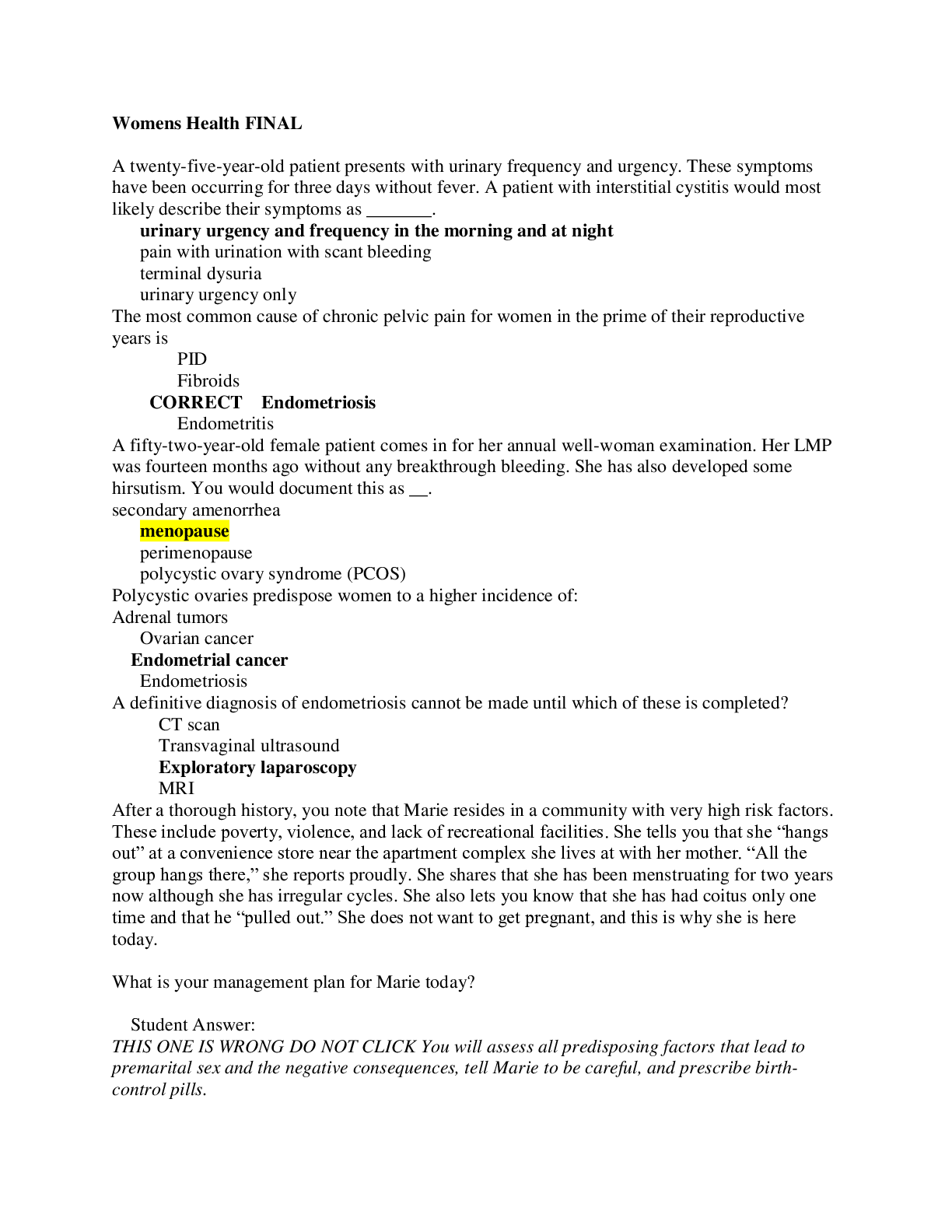
Reviews( 0 )
Document information
Connected school, study & course
About the document
Uploaded On
May 03, 2021
Number of pages
61
Written in
Additional information
This document has been written for:
Uploaded
May 03, 2021
Downloads
0
Views
89

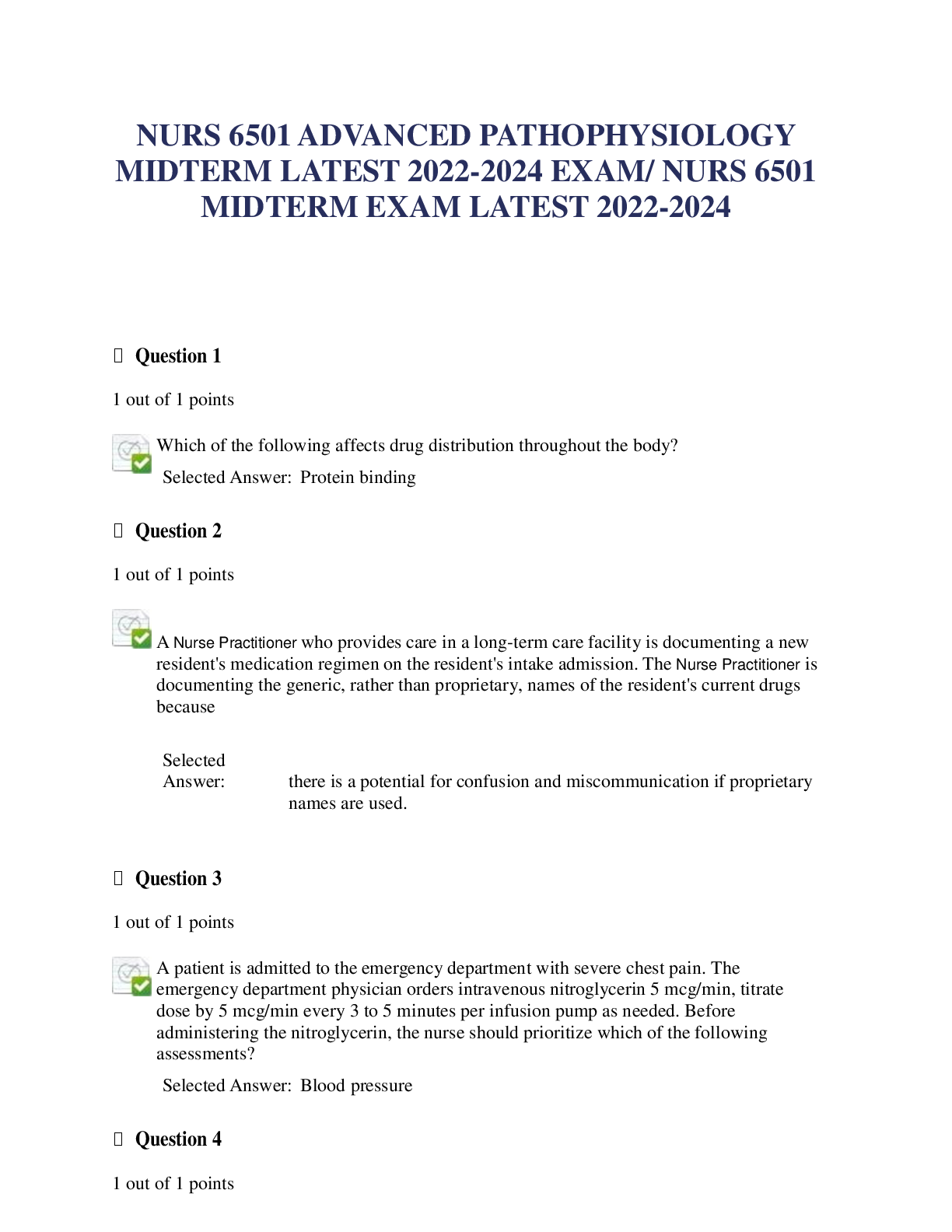
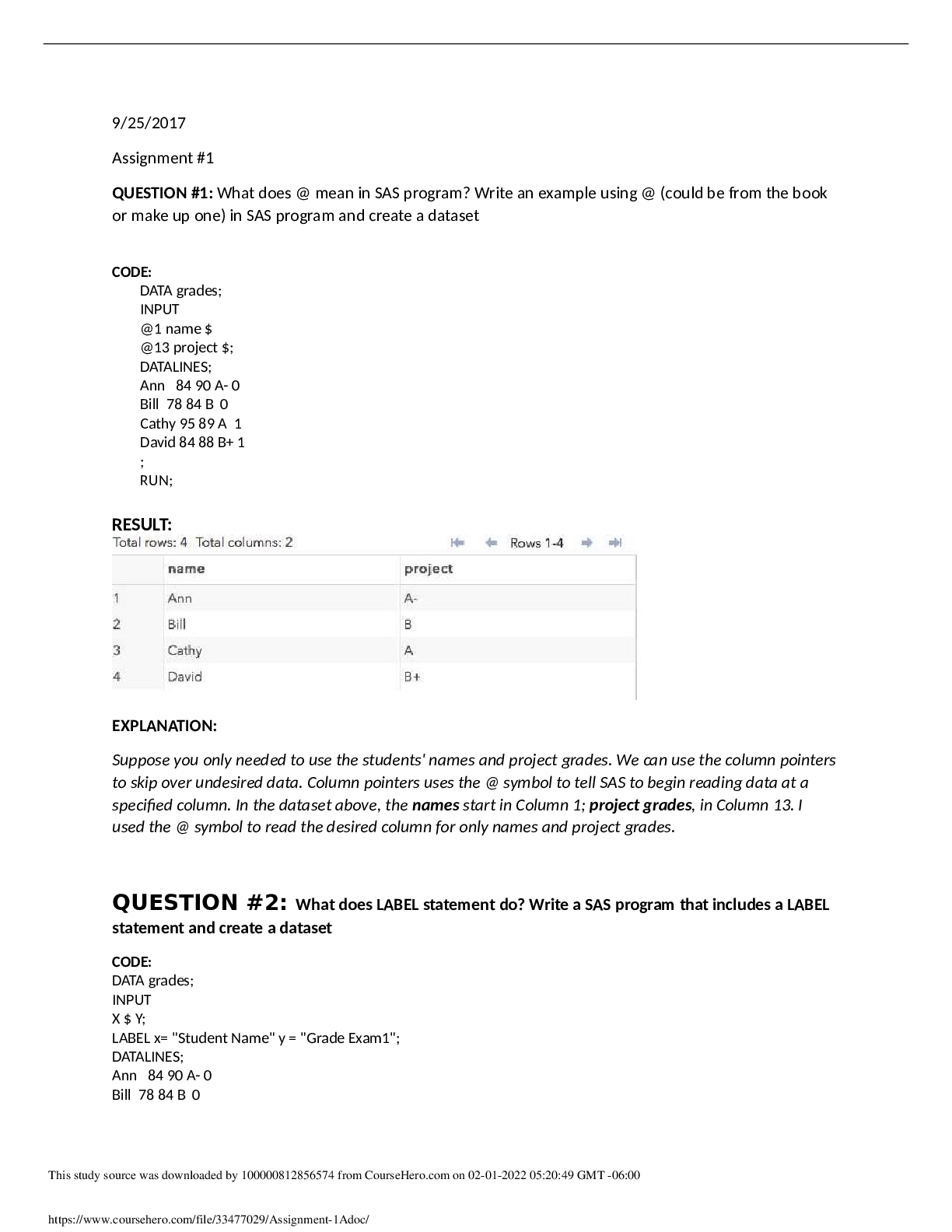
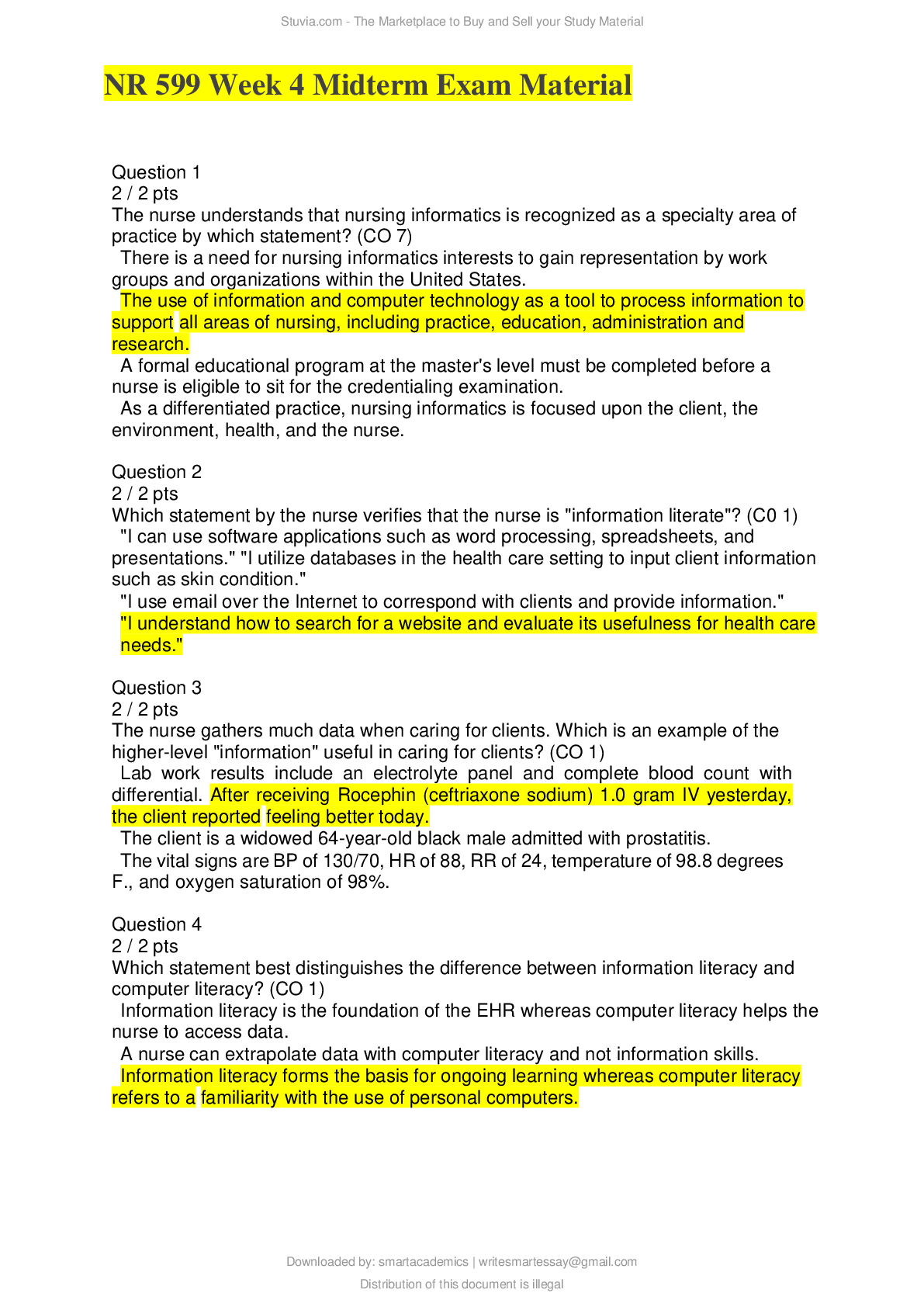

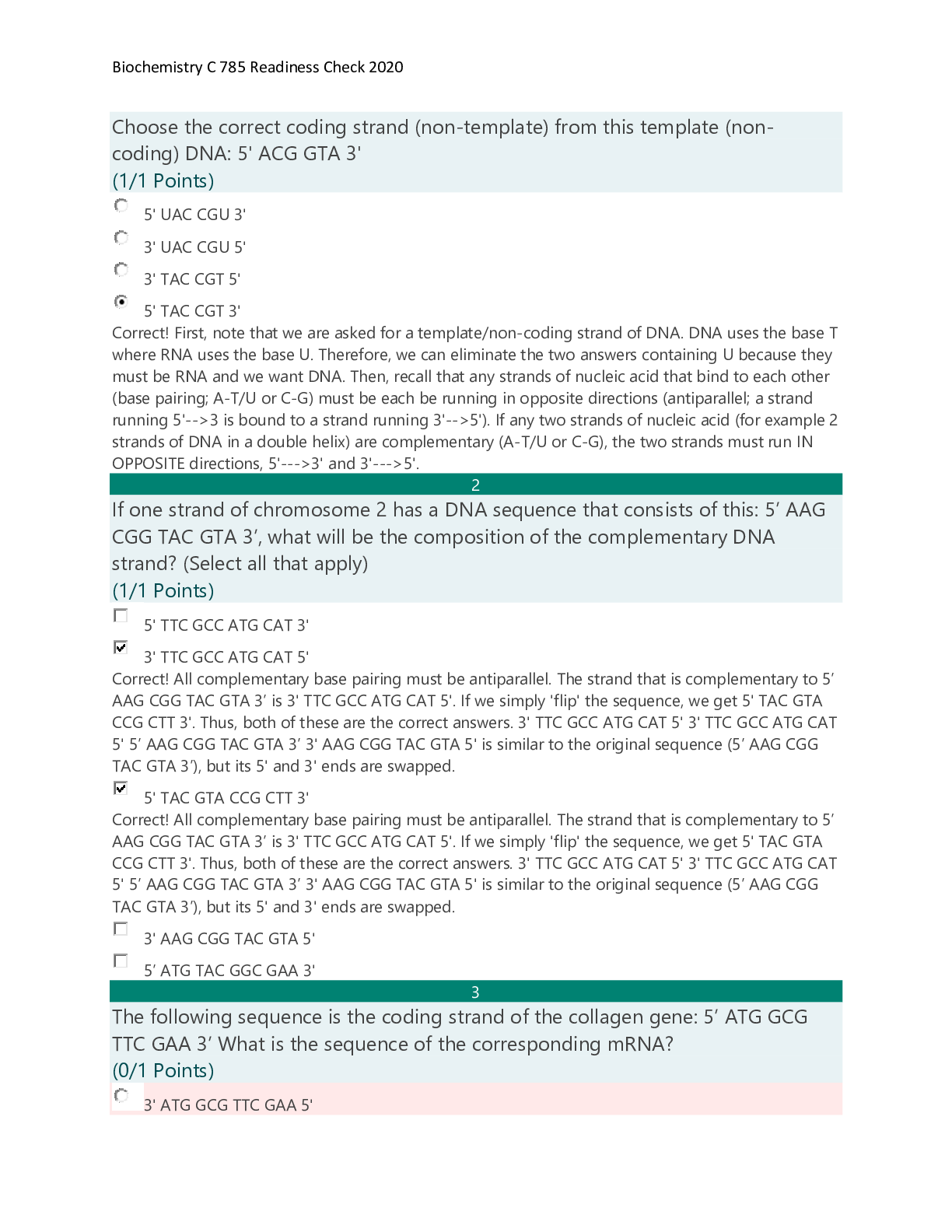
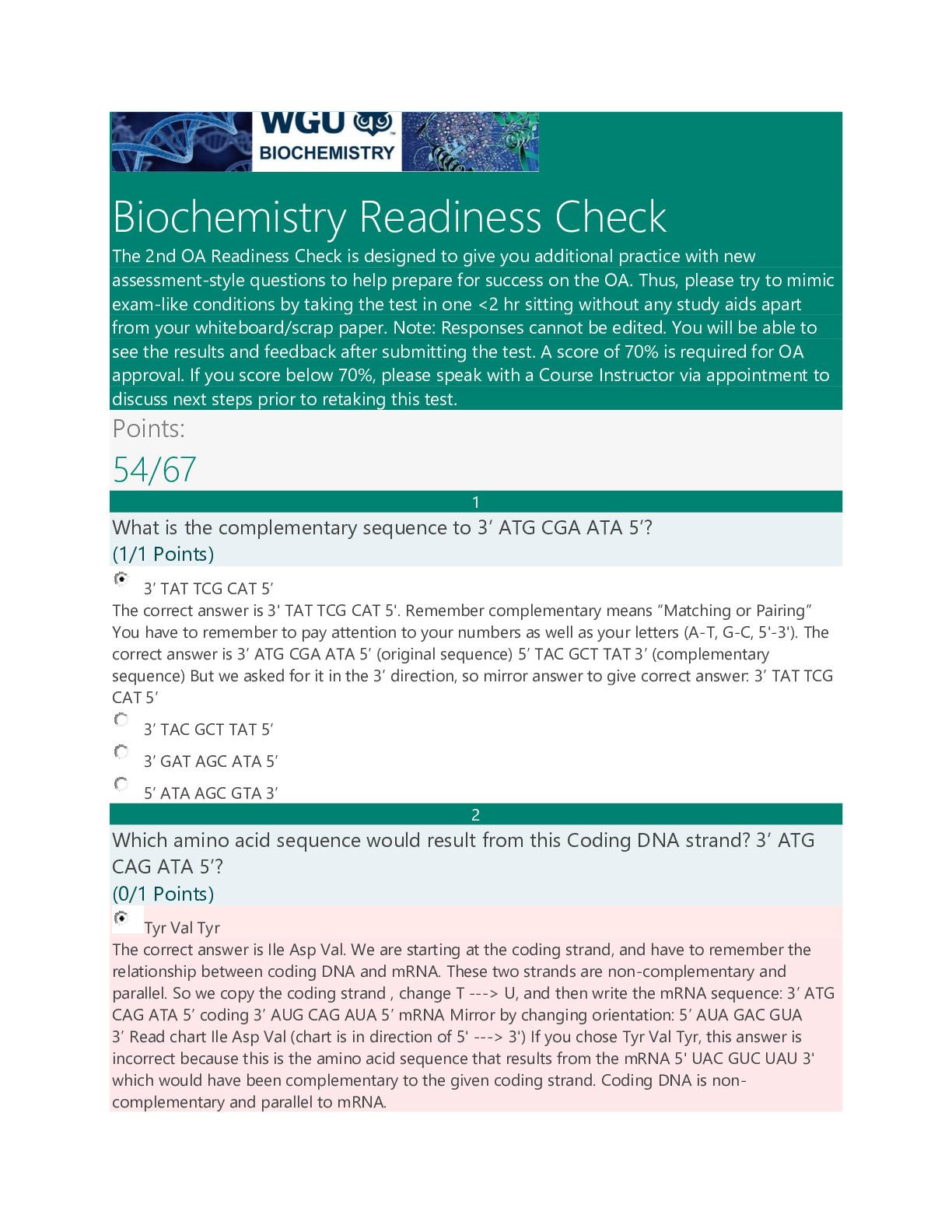
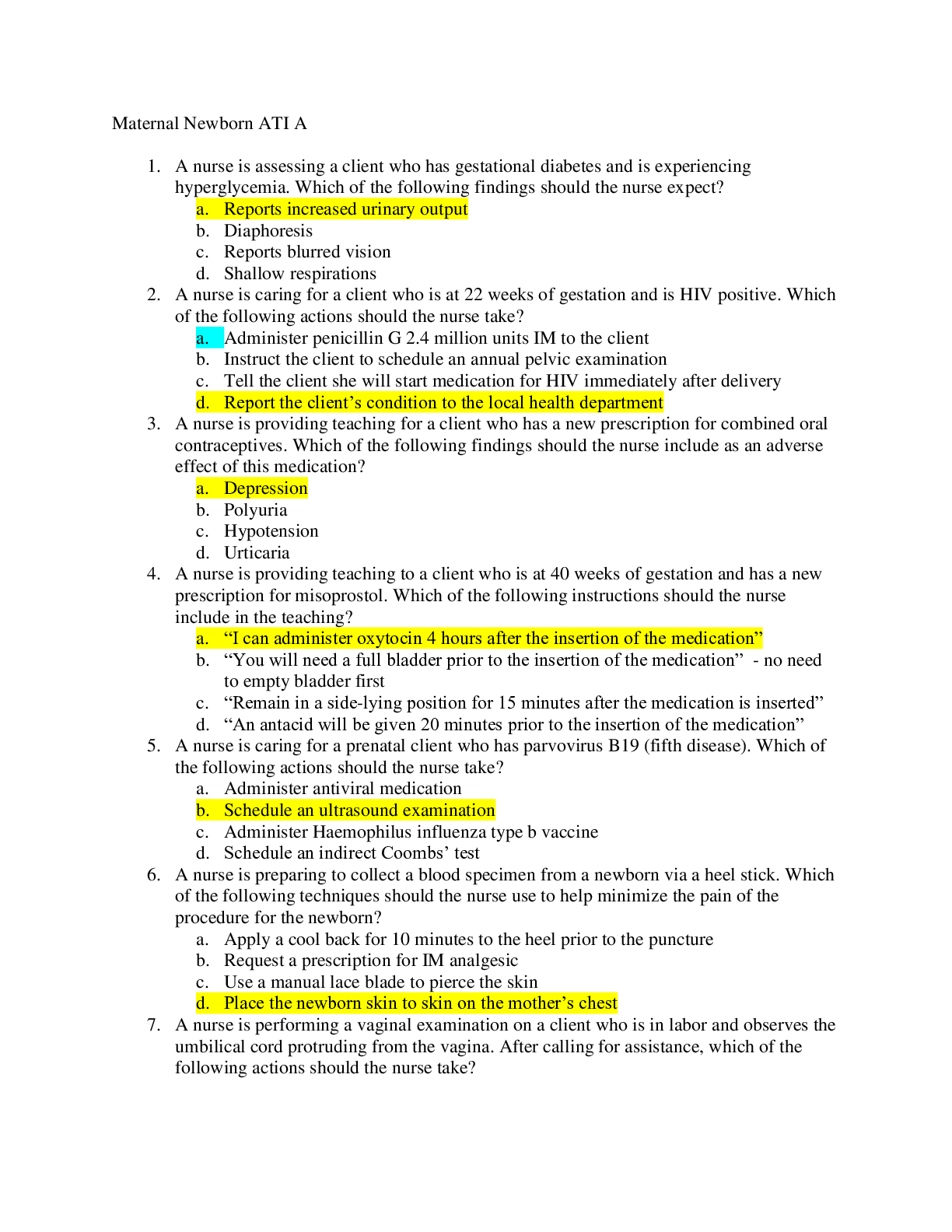

.png)

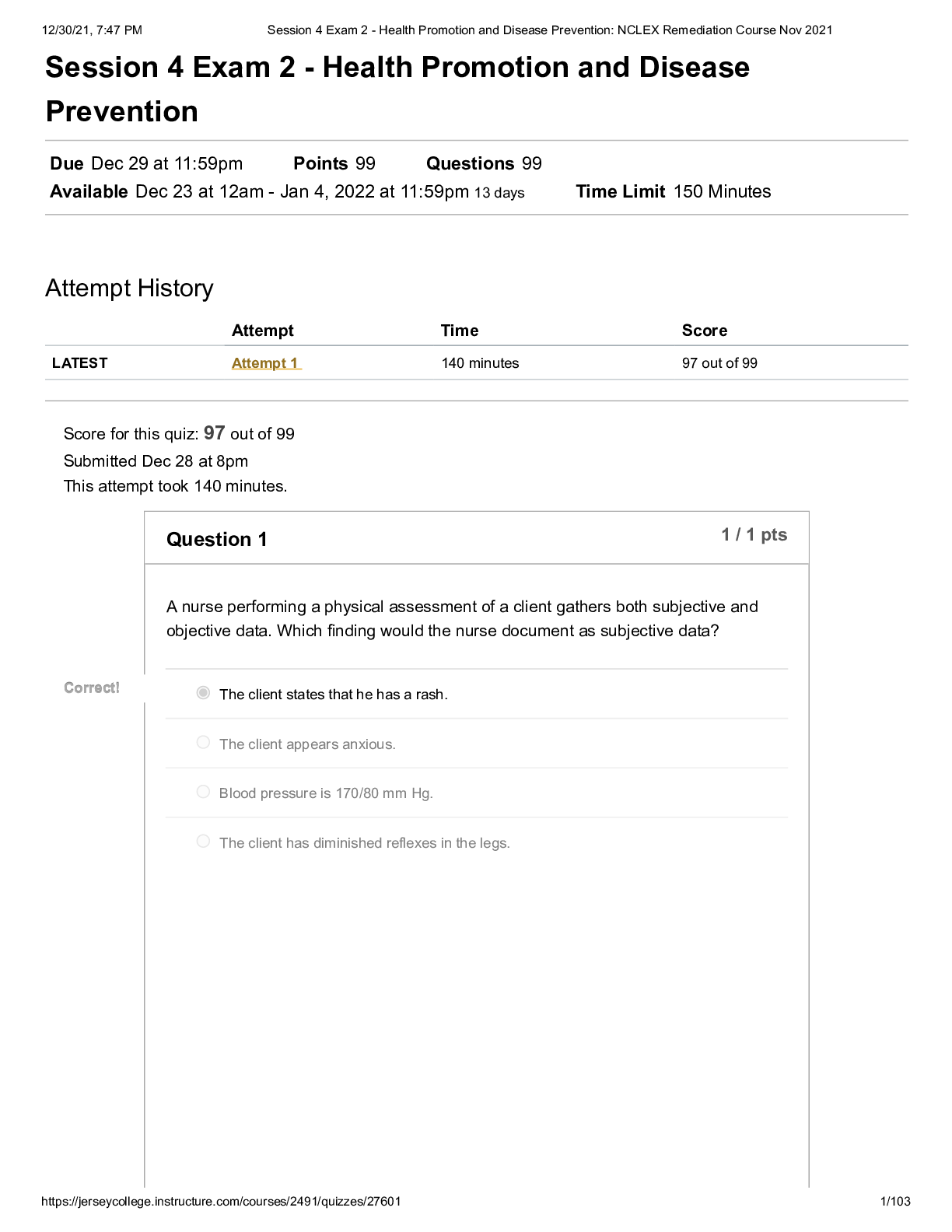
 ORGMED ORGANIC PHARMACEUTICAL PHARMACY.png)
